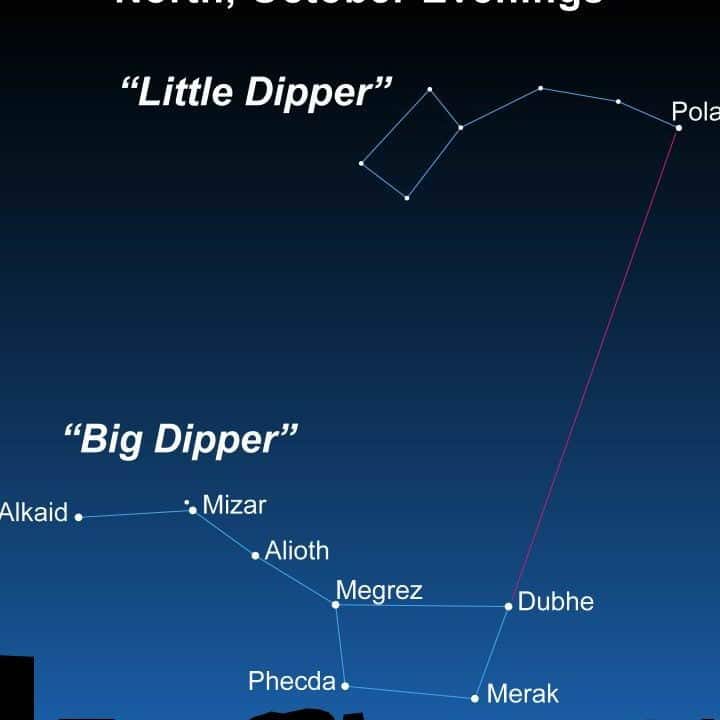The starry sky can be seen as a rather disorganized scene, requiring a vivid imagination to perceive the shapes of people, animals, and objects that the ancient people saw in the randomly scattered stars. However, there are certain mesmerizing star formations that capture our attention! One such drawing is the renowned Big Dipper, which serves as a prominent landmark in our celestial sphere. It is worth noting that the Big Dipper is not an independent constellation, but rather a constituent part of the Big Dipper constellation. So, how can we locate the complete Big Dipper in the sky?
The answer is simple: by moving away from the dipper itself!
However, before doing so, it is necessary to locate the dipper first.
How to locate the Big Dipper in the sky?
Finding the Big Dipper in the sky is simplest during late summer and fall, when it can be seen in the northern part of the sky during the evenings. Wondering where north is? Well, it’s the section of the sky where the Sun never sets! (Unless, of course, you reside above the Arctic Circle.) Locating the north direction is effortless on a clear day: at noon, the Sun is approximately to the south, so north lies in the opposite direction.
Therefore, during autumn, the Big Dipper can be found in the north. It is easy to spot as it is relatively low in the sky and positioned horizontally, as usual.

The Big Dipper can be seen in the northern sky during autumn evenings. Image: Stellarium
During the winter season, particularly in January and February, the shape of the Big Dipper appears to change as the handle starts to move upwards. This phenomenon is not surprising, as all the stars in the sky rotate around the celestial pole every day, following the Earth’s rotation on its axis. Additionally, over the course of a year, the stars also make an extra circle due to the Earth’s orbit around the Sun. The stars of the Big Dipper are no exception to this, and during the second half of winter, they appear to “stand on the fringes” as they shift from their lowest point. During these evenings, the Big Dipper can be observed in the northeast sky.

The Big Dipper can be seen in the winter sky during the evening hours. This constellation takes on an upright position in early spring and reaches its highest point in mid-spring. However, if you are facing south, the bucket of the Big Dipper appears to be upside down! Spotting the ladle can be challenging for beginners, especially during the spring season.
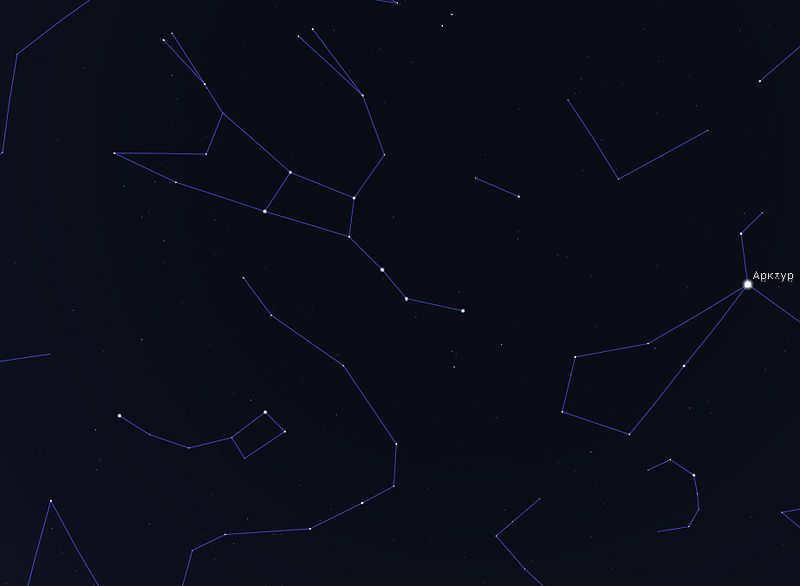
During the spring season, the Big Dipper reaches its highest point in the sky. If you face south while observing it, you will notice that the ladle appears to be inverted. Image: Stellarium
However, in the northern regions of Russia and in areas with temperate latitudes, the ladle is not easily visible in the night sky due to the phenomenon of white nights. On the other hand, in the central and southern parts of Russia, the Big Ladle can be observed perfectly in the western direction and, after midnight, in the northwest. During this time, the constellation appears tilted, with the ladle pointing downwards and the handle pointing upwards.

The position of the Big Dipper’s ladle in the summer sky can be seen in the figure from Stellarium.
What is the appearance of the Big Dipper?
When we locate the Big Dipper in the sky, we are actually identifying the most prominent pattern within the Big Dipper constellation. However, it is important to note that the Big Dipper covers a much larger area in the sky than just its ladle!
It may come as a surprise, but the vast expanse of sky below and to the right of the dipper actually belongs to the Big Dipper constellation. In terms of sheer size, the Big Dipper ranks third among all 88 constellations in the sky, just slightly behind Hydra and Virgo.
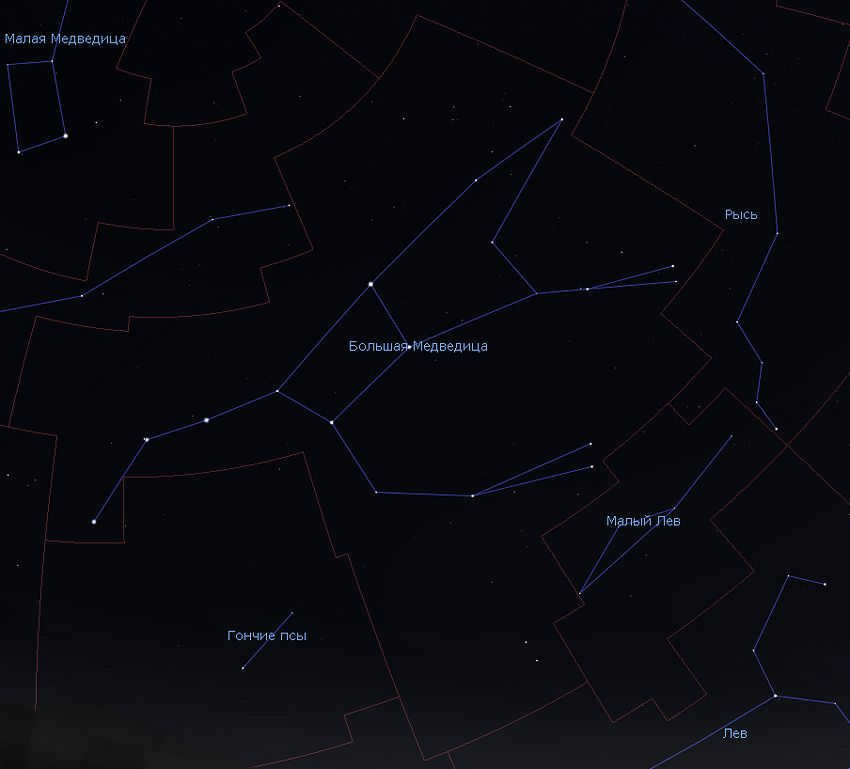
The Big Dipper is an expansive constellation that covers a much larger portion of the night sky than its namesake. In the image above, you can see the boundaries of the Big Dipper highlighted by a red dashed line. Image credit: Stellarium
The Big Dipper consists of 125 stars that are visible to the naked eye in a dark, clear sky. Even in a typical urban setting, you can still spot a few stars from the Big Dipper in addition to the well-known “bucket” stars.
So how do you locate these stars? Take a close look at the Big Dipper. Just to the right of it, you’ll notice two more stars that are nearly parallel to Dubhe and Merak. These stars are known as 23 and upsilon (υ) of the Big Dipper. And if you look even further, you’ll find the omicron (ο) star of the Big Dipper.
On the right and beneath the dipper, you can observe a distinctive triangle composed of the stars theta (θ), kappa (κ), and iota (ι) from the Big Dipper. Right beneath the dipper, there is another triangle that closely resembles the previous one. This second triangle is formed by the stars lambda (λ), mu (μ), and psi (ψ) from the Big Dipper.
The two enclosed triangles bear a striking resemblance to the front and back paws of an animal. In this particular instance, the dipper serves as the bear’s torso, while the dipper’s handle represents the bear’s long and curved tail. (The origin of such a lengthy tail for the bear is a separate tale altogether.) Ultimately, the star omicron takes on the role of the bear’s head, perhaps even its nose.
Undoubtedly, one can already discern the image of a bear within this illustration!
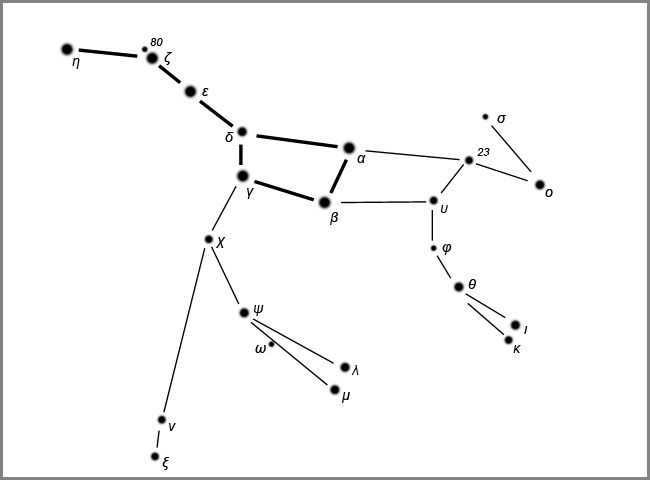
If you gather all the prominent stars in the constellation of the Great Bear, not only the stars of the bear’s dipper, when combined they do indeed bear a remote resemblance to a quadruped creature. Image: The Vast Cosmos
To conclude, there are two additional stars, nu (ν) and xi (ξ), found below each other in the southernmost region of the Great Bear constellation. They are situated so far south compared to the others that at the latitude of Moscow, for instance, they dip below the horizon when the Great Bear is in the northern sky.
The Big Dipper constellation is widely regarded as the primary constellation in the Russian sky for good reason. Its prominent formation, the Big Dipper, remains visible above the horizon at all times throughout the year, making it an exceptional point of reference. This easily identifiable constellation can be used as a reliable guide:
What is the appearance of the dipper in the autumn?
During the autumn evenings, the dipper of the Big Dipper can be observed in the northern part of the sky, positioned low above the horizon. Its orientation is nearly parallel to the horizon, resembling the depiction often found in children’s literature.
Locating the dipper in October or November is a straightforward task. Simply step outside during the early evening and direct your gaze towards the northwest, to the right of the emerging dawn. Alternatively, in the late afternoon, look towards the north. Unless obstructed by tall buildings, the bucket-shaped constellation will become immediately visible.
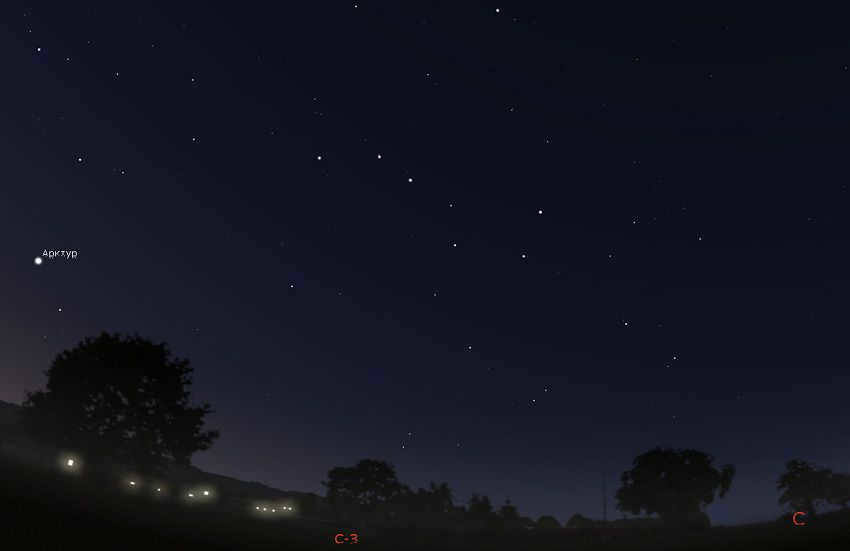
The constellation Ursa Major, also known as the Big Dipper, can be seen in the autumn sky during the early evening hours. This stunning celestial formation can be observed with the help of Stellarium, a popular stargazing software.
In urban areas, the night sky is often obscured by the bright lights of street lamps, making it challenging to locate the Big Dipper. To overcome this issue, it is recommended to seek out locations shielded from direct streetlight illumination. For instance, one can try going around the corner of a building, visiting a park, or strolling along the riverbank. However, if the city is also covered in smog, the visibility of stars becomes even more limited. The tiny droplets of moisture in the smog effectively scatter the light from the streetlights, resulting in a red-tinted sky. In such conditions, only the brightest stars are visible, making it extremely difficult to spot the Big Dipper.
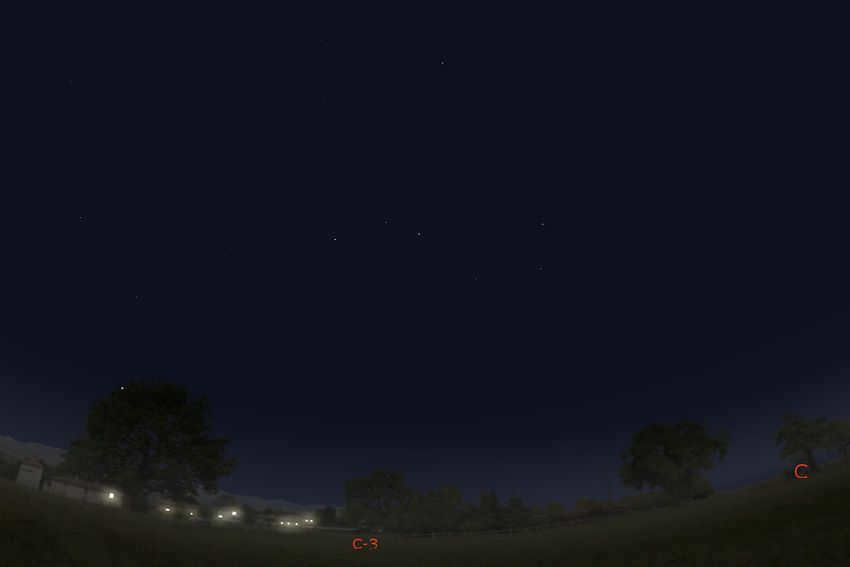
Observing the autumn constellation of the Big Dipper in the illuminated skies of Moscow or St. Petersburg. Image: Stellarium
The Big Dipper consists of seven stars. These are their names (from the bucket to the handle): Dubhe, Merak, Fekda, Megretz, Aliot, Mitsar, Benetnash. All of them have similar brightness, except for Megrets, the central star of the bucket that the handle is “attached” to – it is noticeably dimmer than the others. The names of the stars, which may sound unfamiliar to us, were passed down from Arab astronomers who diligently preserved ancient knowledge during the dark Middle Ages.
The Big Dipper’s bucket during different times of the day
During the evening and night, the Big Dipper’s bucket can be found in the northwest and north. However, as the clock strikes midnight, it starts to ascend on its handle, giving the impression that it is sitting on its haunches. This is the appearance of the bucket in the late October midnight sky.
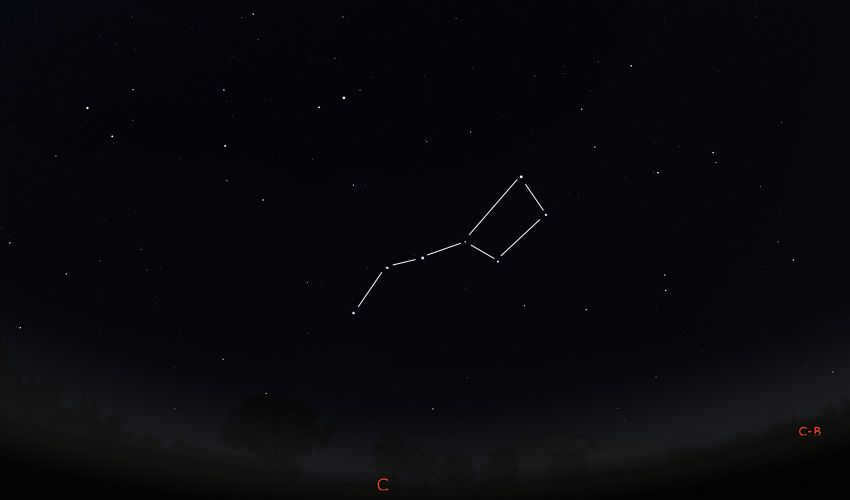
The Big Dipper’s bucket undergoes significant changes in its position during fall nights. In the evening, it can be observed in the northeastern direction, nearly vertical on its handle. As the night progresses, it gradually moves higher above the horizon, assuming a semi upside-down position in the pre-dawn hour.
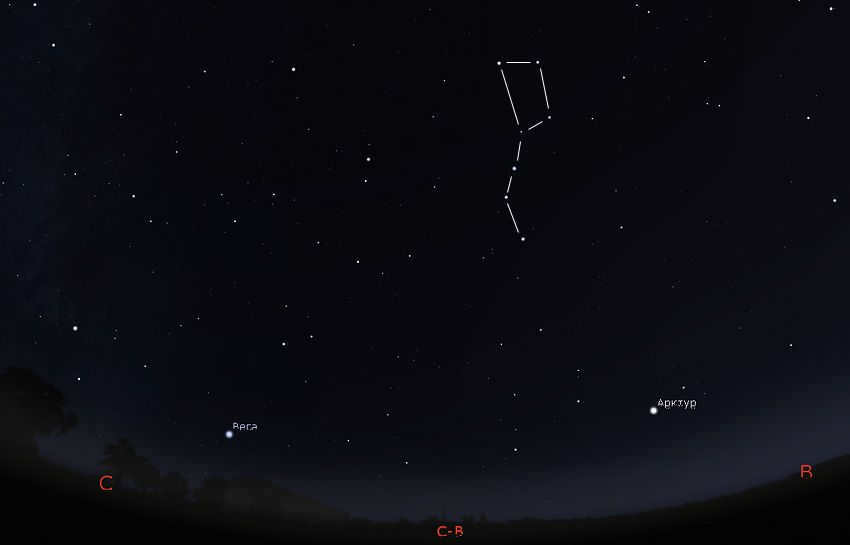
The constellation of Ursa Major’s ladle can be observed moving in a curved path in the morning sky during the autumn season. This change in position is a result of the Earth’s rotation on its axis. Although we are unable to perceive this rotation from our vantage point on Earth, we can observe the apparent rotation of the stars from east to west. It takes the ladle approximately 23 hours and 56 minutes to complete one full circle across the sky, which coincides with the duration of Earth’s revolution.
How can we navigate using the Big Dipper’s ladle?
Let’s attempt to locate some stars by utilizing the Big Dipper.
First and foremost, let’s examine the handle of the ladle. It is fractured in the middle. If you extend the line of the handle further during the early autumn evening, it will lead you to a brilliant star positioned low on the horizon. It is likely to flicker intensely and even display various hues. This star is known as Arcturus, the principal star of Volopassus and one of the most luminous stars in the nocturnal expanse. During the months of October and November, Arcturus can be observed a mere few hours after sunset in the northwest, and in the morning, prior to sunrise, in the northeast.
Polaris is well-known not for its brightness, contrary to popular belief among those who are not well-versed in astronomy, but for its proximity to the celestial pole. As a result, Polaris remains in the same position in the sky regardless of the time of year or day – whether it be night, morning, or evening! All other stars, including the stars that make up the Big Dipper, orbit around Polaris, and it remains steadfast in its place.
Furthermore, another fascinating star can be located by taking the stars that form the top of the dipper, Megrez and Dubhe, and extending a line connecting them to the right. This line will lead you to Capella, a brilliant star that serves as the leader of the constellation Ascendant. During autumn evenings, Capella can be found low in the northeastern sky. However, during winter, it will rise almost to its highest point, surpassing Orion, Taurus, and other winter constellations.
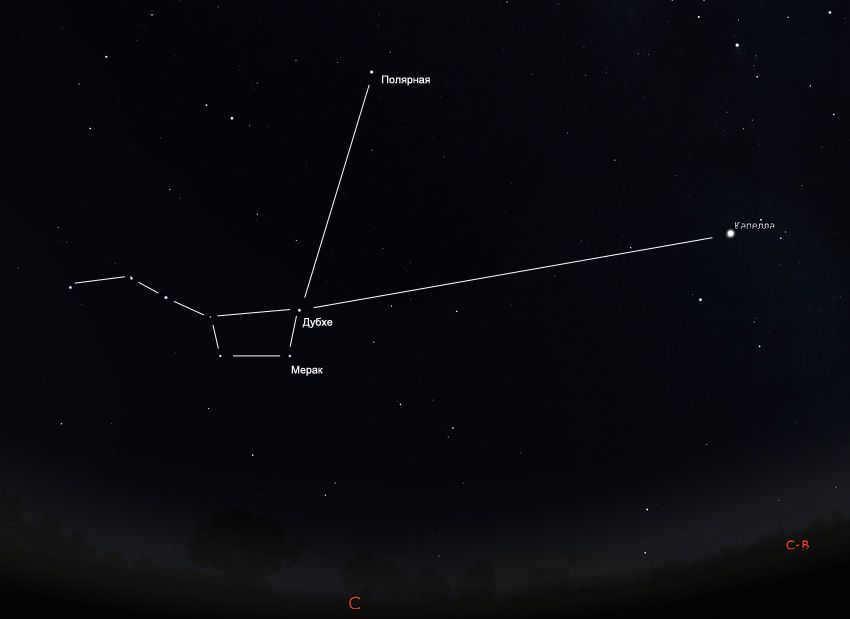

The handle of the Big Dipper can be used as a guide to locate Polaris and Capella. Image: Stellarium
Similar to these examples, the handle of the Big Dipper can also serve as a reference point to find various constellations. Capricorn, Leo, Cassiopeia, and Draco are all constellations that can be easily located if you are familiar with the position of the handle in the night sky.
As you are aware, the major star pattern in the sky of the northern hemisphere of Earth is the dipper of the Big Dipper. This particular dipper is commonly referred to as the Big Dipper. However, in addition to this, there also exists a Small Bucket in the sky, which is part of the constellation known as the Little Dipper. (Were you aware that it contains Polaris?) It would be quite beneficial to be able to locate the Little Dipper in the sky, as it is in close proximity to the celestial pole and can therefore serve as an excellent point of reference in the sky! Let us now explore how to locate the Little Dipper in the sky and how this knowledge can assist us in orienteering.
What is the appearance of the Little Bear constellation?
In order to locate the Little Bear in the night sky, it is important to have an understanding of the physical characteristics of this small constellation. Unlike the Big Dipper, which is significantly larger, the Little Dipper consists mainly of the Little Dipper itself. Some may argue that the Small Bucket is essentially the Little Dipper constellation. (There are a few additional faint stars surrounding and within the bucket, but they are not particularly noteworthy to us.)
Therefore, our exploration of constellations in the sky will be focused on identifying the Small Ladle. Here is its visual representation:
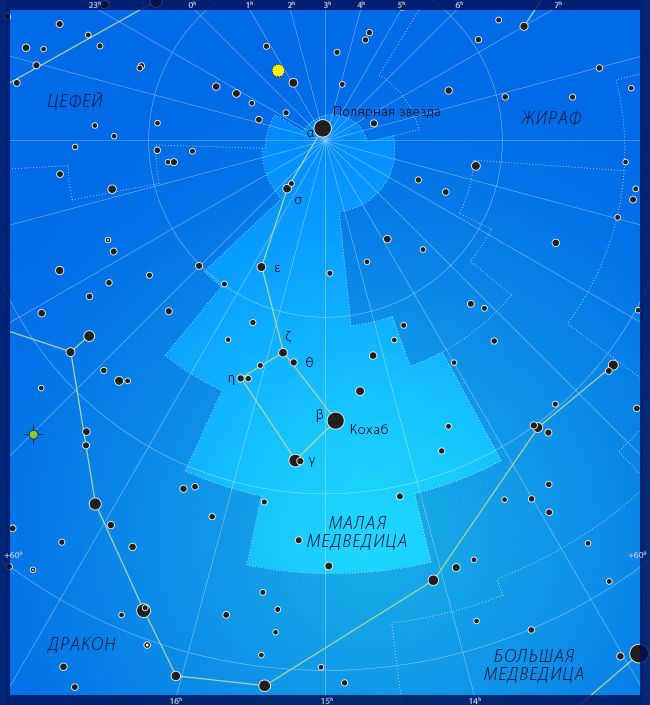
The arrangement of stars in the Little Dipper is displayed on a map. Image: IAU/Big Universe
In contrast to the proper and stunning Big Dipper, the design of the Little Dipper is somewhat unusual, isn’t it? The shape of the ladle appears more like a box, and its handle curves upward in a peculiar manner. It’s amusing to think that the ancient Greeks, who created this constellation, envisioned it as a bear’s long, non-existent tail rather than a handle: it’s as if the bear’s tail is bent upwards like a mutt’s!
Note: the Little Dipper is not as prominent as the Big Dipper. In fact, it only contains three relatively bright stars. Therefore, locating it in the night sky requires some experience and a bit of patience.
How to locate the Little Dipper in the celestial sphere?
Now that we have a general understanding of what we are in search of, we can commence our quest.
The simplest method to locate Ursa Minor is by utilizing Polaris (also known as the alpha star of Ursa Minor), which serves as the principal star of this constellation. Where can Polaris be found? To catch a glimpse of it, you must initially locate the Big Dipper.
In autumn and winter, the bowl of the Big Dipper can be observed low above the horizon towards the north, while on spring evenings, it can be seen towards the east in an erect position with the handle pointing downwards. In the summer, it can be seen towards the west with the handle pointing upwards. For further details, refer to the article on how to locate the Big Dipper in the sky.
Draw a long, slightly curved line from the “bottom” of the Big Dipper to its “opening” and beyond, extending through the outermost stars α and β of the Big Dipper. Polaris is approximately five times the distance between the α and β stars of the Big Dipper. It has a similar brightness to these stars. It’s worth noting that Polaris is not the most luminous star in the sky!
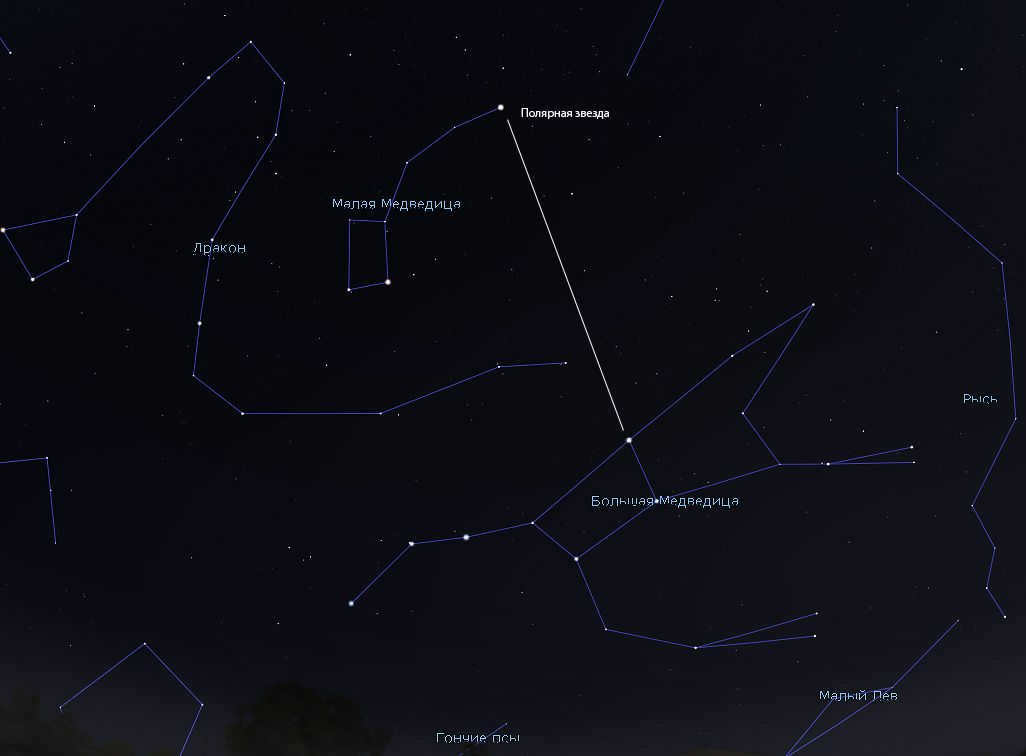

The easiest way to locate the constellation of Ursa Minor, also known as the Little Bear, is by finding its brightest star, Polaris. Polaris can be found along the line that connects the outermost stars of the Big Dipper, Dubhe and Merak (as shown in the image). Figure: Stellarium
Polaris marks the end of the handle of the Little Dipper; the Dipper itself extends from Polaris towards the handle of the Big Dipper. It’s important to note that the handle of the Little Dipper curves in the opposite direction compared to the handle of the Big Dipper.
The Smaller Dipper in the heavens
The remaining four stars of the Smaller Dipper are not always easily seen in the city sky due to their faintness. This is likely the reason why novice stargazers often confuse the Smaller Dipper with the tiny cluster of stars known as the Pleiades.
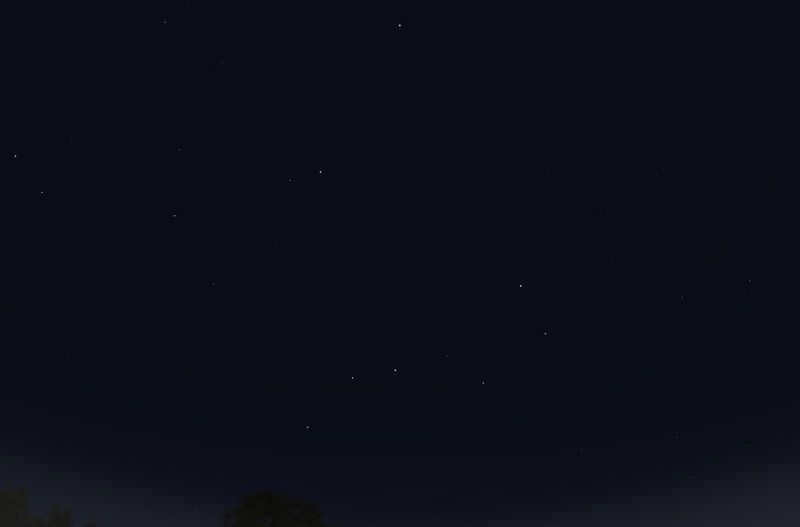

Locating the Little Dipper among the bright lights of the city can be challenging. Due to the intense urban glow, four out of the seven stars that make up the Lesser Bucket are often obscured. Only Polaris, also known as the North Star (located above), and the two stars known as Cohab and Thercade, which are the Guardians of the Pole, remain visible. Image credit: Stellarium
However, once you have spotted the Lesser Bucket in the night sky, you are unlikely to lose sight of it again. The reason is quite simple: this constellation can be found in nearly the same part of the sky at all times of the year and day. Unlike many other constellations, it does not rise or set on the horizon, nor does it follow a circular path like the Big Dipper.
The Little Dipper resembles a massive cosmic pointer connected to the fixed Polaris. This pointer undergoes rotation, completing a full revolution within a single day. (This sets it apart from a typical clock hand, which completes a circle in 12 hours.) Thus, the stars of the Lesser Dipper can serve as a means to measure time. Naturally, if one knows how to do so.
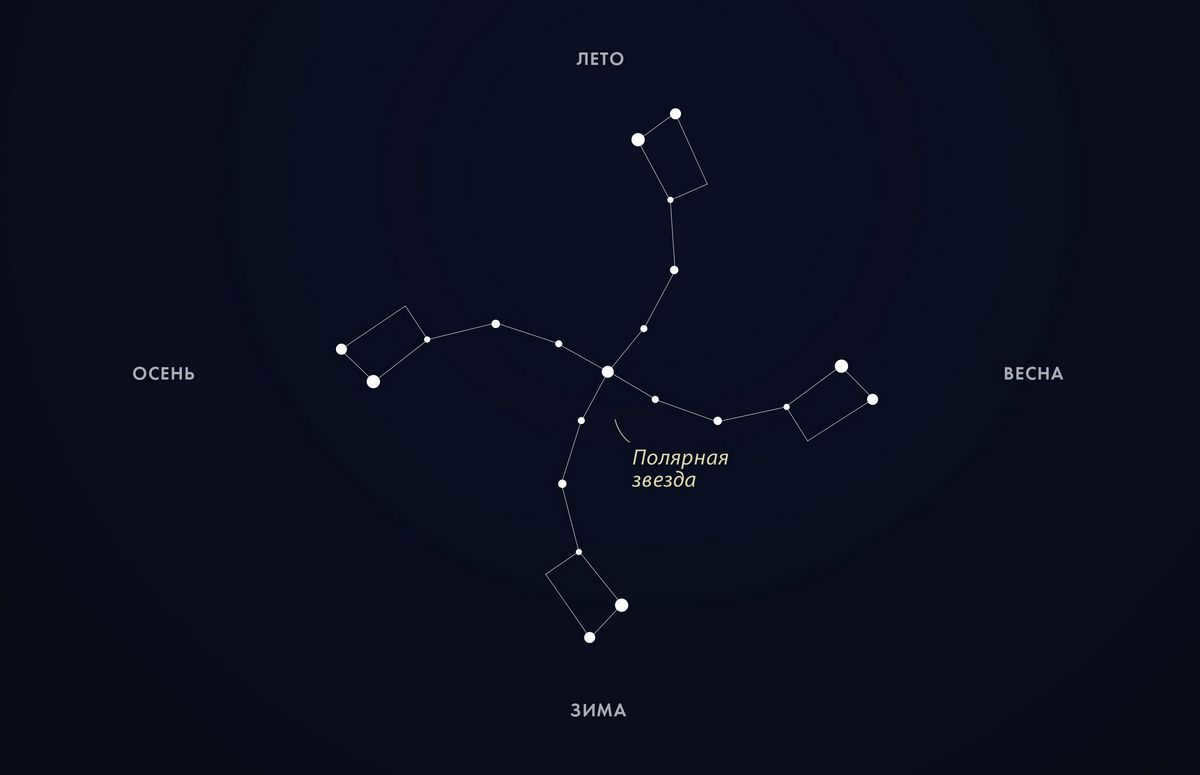
The position of the Little Dipper in the evening sky varies depending on the time of year. Illustration: The Vast Universe
If we take into consideration the fact that Polaris assists in accurately determining the cardinal directions, then the constellation Ursa Minor proves to be exceedingly beneficial!
Since ancient times, people have been observing the night sky. There is an enduring allure in the act of contemplating a clear moon and distant stars. It evokes feelings of well-being and tranquility.
An inquisitive observer will inevitably start to discern patterns in the sky – peculiar clusters of stars that form a multitude of shapes. The Big Dipper constellation will not go unnoticed. We will delve into it in great detail in our article.

Ancient People’s Interpretation of the Big Dipper
The Big Dipper holds a significant place among the constellations that have adorned the night sky since ancient times. Virtually every culture has had references to this captivating group of stars.
The Hindus were the first to take notice of it and bestowed upon it the enchanting name “Sapta Rishi,” which translates to “seven wise men” in Sanskrit. In Chinese astronomy, the constellation was known as the “Northern Bucket.” Resourceful Chinese people started using it as a means to measure time.
The Greeks came up with a fascinating interpretation for the stunning constellation of stars in the heavens. Naturally, the Ursa Major is associated with a myth. According to the tale, the mighty Zeus became enamored with the exquisite nymph Callisto. However, Zeus’ domineering wife, the goddess Hera, disapproved. In order to protect the lovely maiden from the wrath of her overbearing husband, the Thunder God transformed her into a Bear and placed her among the celestial realm. Today, the radiant glow of the captivating Callisto brings joy to all admirers of the starry sky.
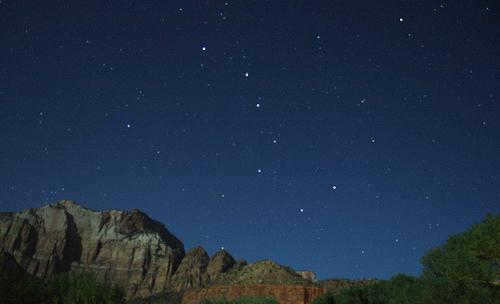
A radiant constellation in the nocturnal sky.
Now contemplate the dipper of the Grand Dipper. During the autumn season, it boasts unparalleled beauty. From a scientific standpoint, this constellation is the third largest in terms of area, trailing only Hydra and Virgo. It covers a whopping 1,280 square degrees. The Grand Dipper (also known as the bucket, as depicted in the photograph below) comprises a visible grouping of seven dazzling stars. Allow me to enumerate them:
- Dubhe – the Bear;
- Merak – the Loin;
- Fekda – the Thigh;
- Megretz – the commencement of the Tail;
- Aliot – the Curdle;
- Mitzar – the Loincloth;
- Benetnash – the Leader of the Mourners.
All of these names originate from Arabic and represent the 7 brilliant stars that compose the fabled Bucket.
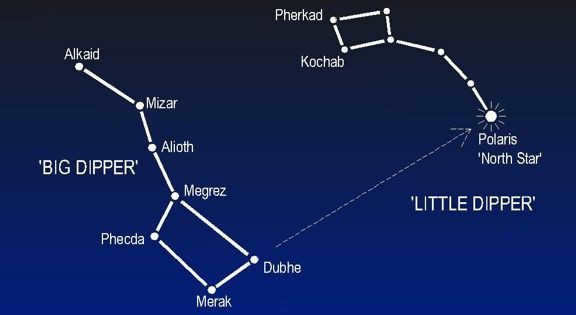
Position in the Celestial Sphere
The constellation of Ursa Major is an essential part of the starry sky. During the autumn season, it can be found in the northern region of the celestial sphere. Its visibility is most prominent between 3-4 o’clock in the morning, appearing above the northeastern horizon. A useful indicator is the handle of the Big Dipper, which points towards the direction of the sunrise.
For beginners in astronomy, it is important to learn how to locate the Big Dipper in the autumn season (see photo below). This particular group of stars is easily visible in the night sky and serves as a great starting point for young astronomy enthusiasts to delve deeper into their study of the celestial sphere. This exercise helps in:
- identifying other, less prominent constellations in the sky. Experienced astronomers often use the Big Dipper as a reference for locating other stars;
- developing an interesting method of observing the sky throughout the year. This allows one to observe how familiar stars change their positions, where they rise and set, and so on;
- practicing basic calculations. Over time, individuals can memorize the distances between the angular stars of the dipper;
- The initial experience of using a handheld telescope allows young astronomers to discover stars that are not visible to the naked eye. This includes the observation of double and variable stars, and there is even a possibility of spotting the explosive galaxy M82.
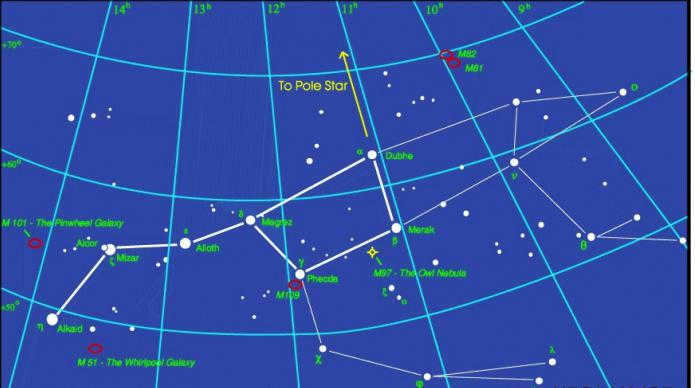
The Big Dipper: the bucket during autumn
The position of the constellations largely depends on the time of the year. The Big Dipper (dipper) during autumn is no exception to this rule.
The autumn sky is not particularly abundant in stars. Even the traditionally bright Big Dipper constellation appears dimly. The bucket of the Big Dipper during autumn can be found in the northern sky, below Polaris, with its tail pointing west. Cassiopeia is positioned at the zenith.
However, in the eastern sky, the Pleiades constellation rises high, and the bright star Aldebaran, located in the Taurus constellation, shines prominently beneath it. During this time, two bright stars rise in the northeast, which an experienced stargazer will immediately recognize as Gemini.
The Earth blocks the view of the Leo and Virgo constellations, rendering them invisible. However, if you look towards the west of the Big Dipper, you may be able to make out the faint constellation of the Eagle.
To summarize, the following constellations can be observed in the northern part of the night sky during the autumn:
- The Big Dipper;
- The Little Dipper;
- Gemini;
- Taurus;
- Lyra and Cygnus.
Once you have located the ladle of the Ursa Major during autumn, you may become engrossed and spend an hour or two exploring for other recognizable stars. The key is to have a genuine desire and, of course, a star chart would be helpful.
Now, let’s turn our attention to the southern region of the sky. It is in this area where Andromeda and Pegasus ascend each autumn. In the upper left corner of the sky, you will always find two stars from the former constellation, followed by three stars from the latter constellation.
Andromeda consists of four stars that are widely separated from each other. The constellation itself is situated below Cassiopeia. Andromeda somewhat resembles the shape of a bow. This bow is perfectly aimed towards the Pleiades and Taurus. It almost appears as if an arrow is ready to be released from the bow and travel to the left, in the direction of these constellations. However, this is purely a figment of the imagination and has no relation to the grandeur of the starry sky.
Beneath Andromeda, you can observe two small stars – those are Aries. And below it, there are numerous bright dots – that’s the constellation of Cetus. Aries and Cetus can only be seen during clear weather.
In Pegasus, aside from the three prominent stars, it is important to also recall two others: they can be found on the right. The actual shape of Pegasus resembles horns. It almost appears as if they want to nudge the Swan.
Image: the handle of the Big Dipper in autumn

There’s nothing quite like gazing at the night sky to inspire creativity. It’s a transformative experience that can ignite the desire to engage in various forms of artistic expression. Some may be inspired to write captivating stories about their nocturnal adventures, others may feel compelled to dance to their favorite music, and still others may be motivated to create a sketch of the glowing bucket.
In this article, we will focus on the latter form of artistic expression – sketching the Bear.
Try to express some of your emotions through your artwork, and it will result in a truly captivating piece. As you can observe, depicting the handle of the Ursa Major constellation during the autumn season is quite effortless.
For the first grade students of the Environmental Science class, here is a guide on how to accurately complete page 2 of the Science Diary.
With the assistance of an adult, locate the handle of the Big Dipper constellation in the night sky during the fall, winter, spring, and summer seasons. Take note of its positioning in the sky and illustrate it. With the help of an adult, document the date and month of each observation.
The solar system is a component of the galactic star system and is firmly governed by the laws of motion that apply universally. These laws give rise to various simultaneous processes occurring within the solar system as a whole:
- Rotation around its axis;
- Revolution around the nucleus;
- Very gradual rotation around the axis of the Earth;
- Even slower oscillation from side to side.
The correlation between the axis of the Earth (referred to as the “World Mountain” in ancient myths) and the constellation of the Big Dipper in the northern hemisphere is evident in numerous legends.
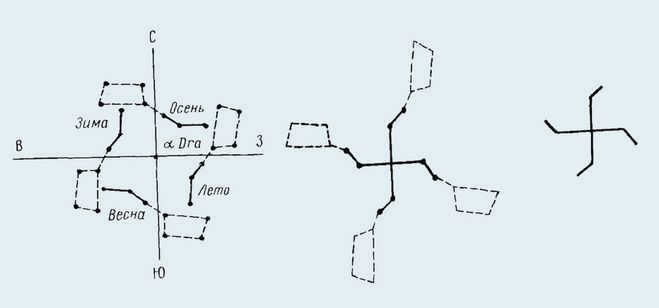
If you observe this rotation closely, or even better, draw it, dividing it into seasons, you will notice an ancient symbol – the “sign of eternity”. It represents the image of the sun’s rays and symbolizes the rotation of the sky.
To start filling out the science diary for the 1st grade on the topic of the Environment, you should go outside with your parents in the evening and observe the starry sky. Take note of how the arrangement of the stars in the Big Dipper constellation visually changes.
After observing this, draw the shape of the Big Dipper as follows:
And make sure to mark the dates for observing the autumn, winter, spring, and summer constellations.
Observing the night sky is a highly thrilling activity. It rarely becomes dull for an attentive observer. To complete the task of observing the handle of the Big Dipper, it is necessary to observe it at various times throughout the year, noting if it is approximately the same time. Alternatively, computer programs can be utilized to simulate the night sky as seen from a specific location with specified geographic coordinates, observation time, and date. The outcome should resemble something similar to the image depicted below.

Take notice of the striking resemblance between this image and the age-old Slavic emblem known as the “Rodovik”.
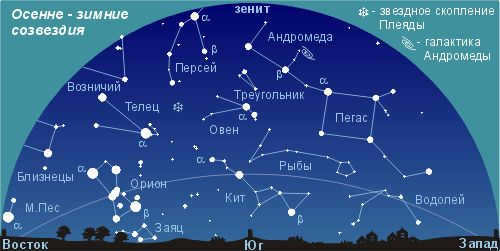
In preparation for the arrival of winter constellations, the sky at the end of autumn puts on a show. Right after the sun sets, Jupiter becomes visible, followed by Saturn in the late hours of the night. Venus and Mercury make a brief appearance before dawn. However, Mars is hardly noticeable in November. On the other hand, the last six constellations of fall rise prominently above the horizon.
Constellations of the fall skySeptember October November
The Andromeda Galaxy
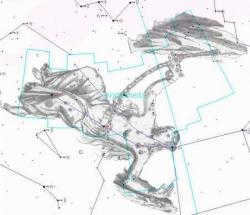
Andromeda, the oldest constellation in the northern hemisphere, is home to the Andromeda galaxy. It is a sizable constellation, covering an area of 722 square degrees, which ranks it 19th in terms of size.
Andromeda can be observed throughout Russia and is visible all year round, with October being the optimal time. To locate the constellation in the night sky, one simply needs to find the square of Pegasus. In the northeastern corner of this square, there is a bright star called Alferats, also known as Alpha Andromeda. It marks the beginning of Andromeda, whose shape resembles a fist with three rays converging at Alferats.
With the naked eye, one can spot nearly 160 stars within the constellation. Among them, three stars – Alferatz, Mirach, and Alamac – have a magnitude of second star.
One of the most captivating entities within the constellation is the Andromeda Nebula, a spiral galaxy. It stands out among the few galaxies that can be observed by the naked eye, without any assistance from optical instruments.
The Andromeda Nebula also encompasses another spiral galaxy, multiple star clusters, and a planetary nebula.
Cassiopeia
Cassiopeia is a constellation in the northern sky. It is named after the vain queen Cassiopeia in Greek mythology, who boasted about her unrivaled beauty. The constellation is easily recognizable because it resembles the letter “W” or “M”, depending on its orientation in the sky. Cassiopeia is located in the Milky Way, and it is one of the 48 constellations listed by the Greek astronomer Ptolemy in his Almagest. It is visible year-round in the northern hemisphere and is best seen during the autumn months. Cassiopeia contains several notable stars, including the bright star Schedar and the supernova remnant Cassiopeia A. The constellation also hosts various deep-sky objects, such as the Heart Nebula and the Pacman Nebula.
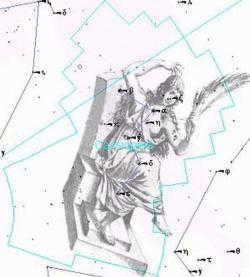
A stunning and exquisite constellation situated in the northern hemisphere, encompassing an area of 598 square degrees. It bears a remarkable resemblance to the letter W and boasts approximately 150 stars that can be easily identified with the naked eye. However, it is the five brightest stars that truly define the constellation’s distinctive shape.
Locating Cassiopeia in the night sky is an effortless task. Simply draw an imaginary line from the Big Dipper to Polaris and extend it further. This line will lead you directly to the captivating constellation of Cassiopeia.
Overall, Cassiopeia and the Big Dipper are the two constellations in the northern hemisphere that never set, with Cassiopeia being positioned on either side of Polaris.
The five principal stars within the constellation each possess their own unique names: Shedar, Rukbach, Navi, Seguin, and Kaf. All of these stars shine at a magnitude of second star and can be effortlessly observed even without the assistance of binoculars.
One of the fascinating stars in the constellation of Cassiopeia was first observed in 1572. This celestial body was given the name Tycho Brave’s Star, after its discoverer. It was a supernova star that experienced a sudden burst of brightness and then faded away within a period of 16 months.
Within the Cassiopeia constellation, there are also numerous dwarf galaxies, multiple nebulae, and various star clusters.
Phoenix
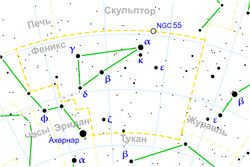
Constellation Phoenix is a small group of stars located in the southern hemisphere. It covers an area of 469 square degrees and consists of approximately 70 stars that can be easily distinguished within this space.
The shape of the constellation resembles that of a bird, with an elongated pentagon representing its body and two broken lines extending from the tips as wings. While fully visible in the southern hemisphere, it can only be observed south of the 32nd parallel in the northern hemisphere.
To locate the Phoenix constellation in the night sky, you must connect an imaginary line between the two most prominent stars in this region: Ahernar in the Eridanus constellation and Fomalgaut in the southern part of Pisces. In between these stars, you will find another bright star called Anka, which serves as the Alpha star of the Phoenix constellation.
Phoenix is a recently recognized constellation, officially designated by P. Plancius in 1598. Additionally, within this constellation, observers can also spot two galaxies and a meteor stream.
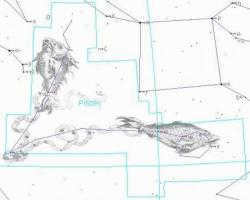
A large group of stars in the northern hemisphere, situated between Aquarius and Aries. Pisces covers an expansive region of 889 square degrees and contains over 75 stars that can be seen with the naked eye.
An interesting feature of this constellation is its division into two sections: North and South. The overall shape of the constellation resembles a large letter V. One arm extends towards Andromeda, while the other terminates in a pentagon and passes by Uranus. These arms converge at the star Alrisha, also known as Alpha Pisces. Within the “fork” of the constellation lies the square of Pegasus. The Pisces constellation can be observed across Russia from early autumn until almost January.
Despite its vast expanse, the constellation appears faint due to the absence of any first or second magnitude stars. However, it is home to the vernal equinox point.
One of the fascinating entities found in the vastness of outer space is a spiral galaxy that has witnessed the birth of two newborn stars and the emergence of a newly formed black hole within the span of the past five decades.
Sculptor
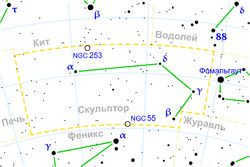
This is a small constellation located in the southern hemisphere. It covers an area of 464 square degrees. Within this region, up to 55 stars of the Sculptor constellation can be observed without the need for optical aids.
Sculptor belongs to the category of newly discovered constellations, as it was identified by N. Lacaille in 1756.
Locating this constellation in the night sky is relatively easy. Simply draw a line from the head of the Phoenix to Aquarius, and along this path, you will encounter the Sculptor constellation. However, it can only be observed by residents of the southern regions of Russia.
The Sculptor constellation is faint, with its brightest star, Alpha, having a magnitude of only 4. However, it is within the boundaries of this constellation that the South Pole of our Galaxy is situated.
There are a few extraordinary celestial bodies that can be seen as a component of the Sculptor. This includes an elliptical-shaped dwarf galaxy and the massive spiral galaxy known as Silver Coin.
Toucan
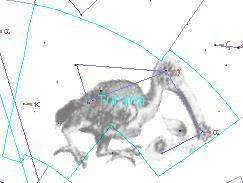
Tucana is the last constellation of November and can be found in the southern hemisphere. It is the 48th largest constellation, covering an area of 295 square degrees. Alpha Tucana, a second magnitude star, is the only bright star in the constellation. However, on a clear night, more than 50 stars of Tucana can be seen with the naked eye.
One of the reasons Tucana is famous among astronomy enthusiasts is because it is home to the Small Magellanic Cloud, one of the most well-known galaxies. This galaxy is a satellite of our Milky Way.
Additionally, Tucana contains a dense cluster of bright stars and pulsars.
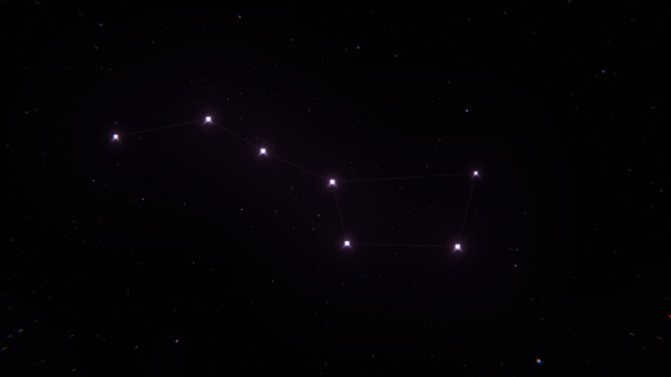

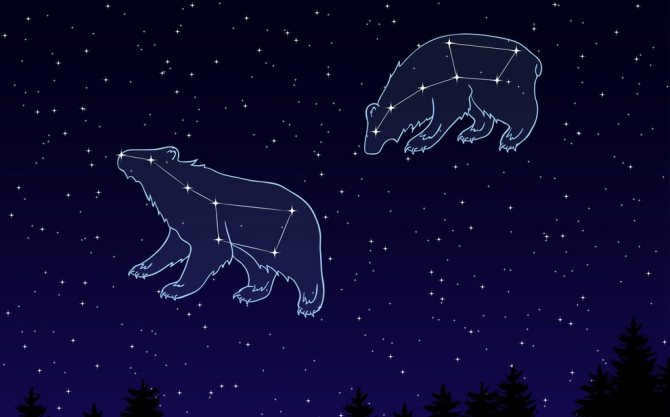
The solution is straightforward: by shifting the position of the spoon!
However, the first step is to locate the ladle itself.
An Overview of the Great Bear as it appears, its description, and features
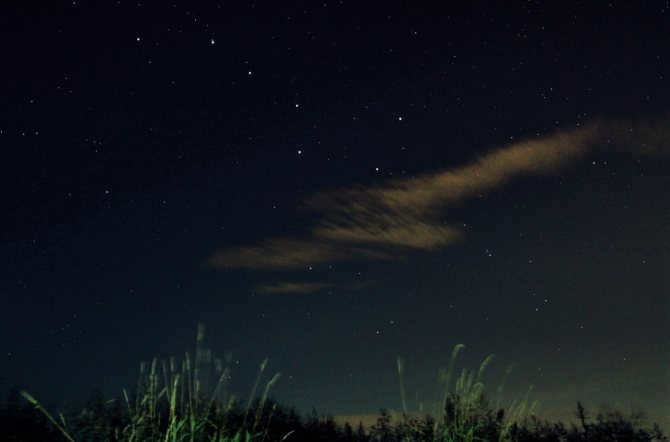
Here is a photograph capturing the stunning view of the Big Dipper constellation in the night sky.
The Big Dipper, also known as Ursa Major, is the third largest constellation. It covers a significant portion of the starry sky, occupying more than 3% of it, with an area of 1279.66 square degrees. This constellation revolves around Polaris, which ensures its visibility above the horizon throughout the year.
Comprised of seven bright stars, the Big Dipper resembles a bucket with a handle. Its Latin name is Ursa Major, and it is commonly abbreviated as UMa.
There is an extensive array of constellations bordering the cluster. This is not surprising, given its remarkable size. The neighboring constellations include: Draco, Camelopardalis, Coma Berenices, Canes Venatici, and both Leo constellations.
Fascinating fact: Since the Big Dipper sinks to the horizon in autumn, there was a legend among Native Americans that this is how the animal prepares for winter hibernation.
In Russia, the cluster is visible throughout the year, but its stars shine much brighter in April compared to other months. By observing the movements of the Big Dipper, one can determine the month and approximate date. Additionally, ancient Chinese people were able to tell time by the position of the handle of the Big Dipper.
The Big Dipper is a constellation that can be seen all year round in the northern latitudes. It is considered circumpolar, meaning it never dips below the horizon. The Big Dipper’s position is constantly changing as it revolves counterclockwise around the polar star, which is located in the neighboring constellation of the Little Bear. This movement has been observed and utilized by people since ancient times, making the Big Dipper a reliable star clock.
What is the method for locating the Big Dipper in the night sky?
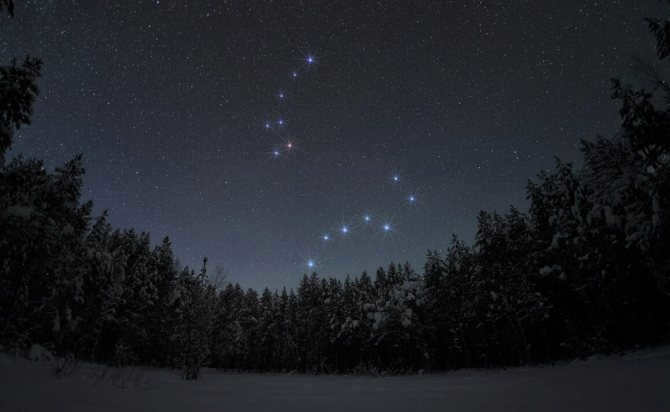
Image of the Ursa Major and Ursa Minor constellations
Finding any constellation in the night sky can be quite challenging without specialized equipment. However, locating the Big Dipper is relatively easy due to its distinct shape. All one needs to do is locate this prominent pattern, and the problem is solved.
During late summer and early fall, the Big Dipper can be found in the northern part of the night sky. For optimal viewing, it is recommended to wait until nighttime and venture outside the city to avoid the interference of artificial light from houses and streetlamps.
Interesting fact: It is simple to determine north by observing the position of the Sun at noon. The star will be in the opposite direction, towards the south, during this time.
Due to the rotation of the Earth around the Sun and its own axis, the configuration of constellations in the celestial sky changes gradually when observed from a specific point. As a result, between January and February, the Great Bear constellation undergoes a gradual circular rotation: The container shifts from a horizontal position to a downward tilt with its handle. Additionally, the actual position of the cluster gradually shifts towards the northeast.
During the spring season, it becomes more challenging to locate the Great Bear constellation in the starry sky. During this time, the pattern eventually flips to an “upside-down” position, which could easily be missed by someone lacking knowledge in astronomy.
The Big Dipper is not easily visible in northern Russia. This region often experiences white nights, which make it difficult to see any stars. Additionally, when observing the constellation from the central and southern regions, it is important to note that the Bucket appears with the handle pointing upward at this angle.
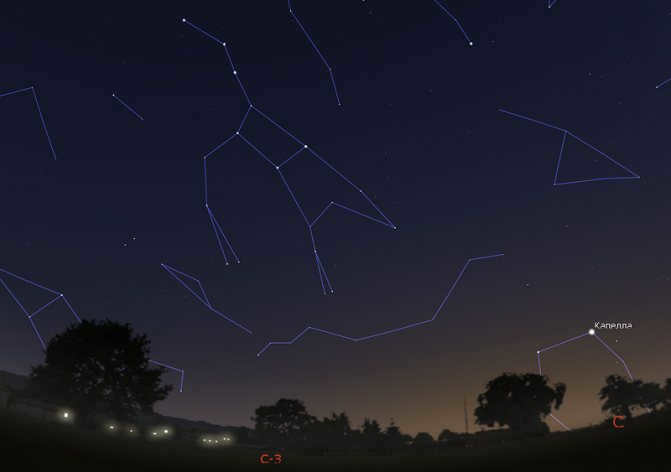
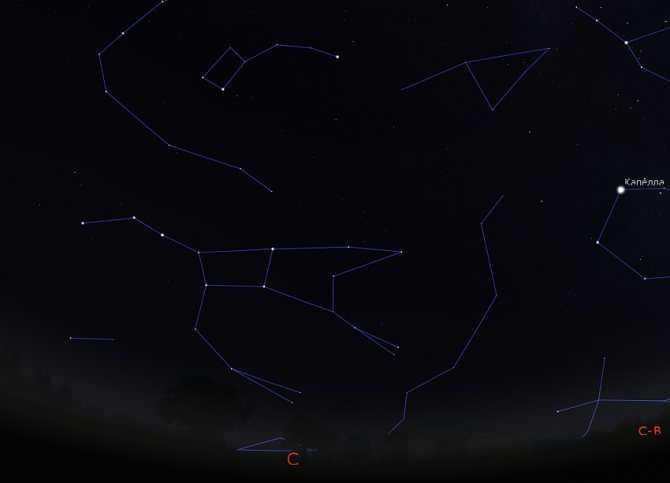

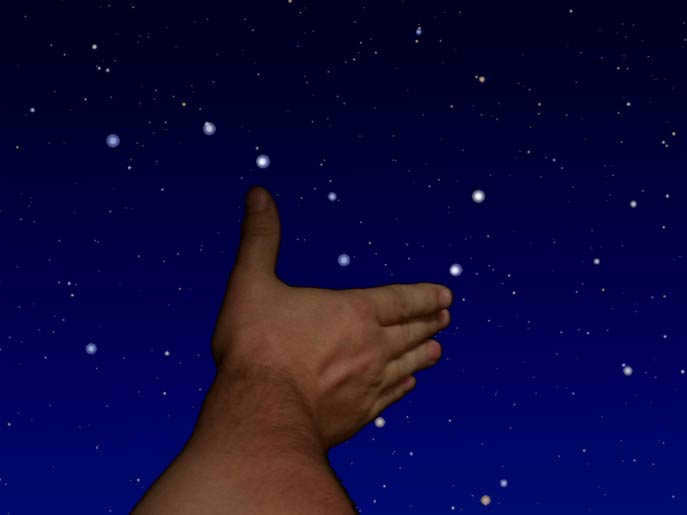
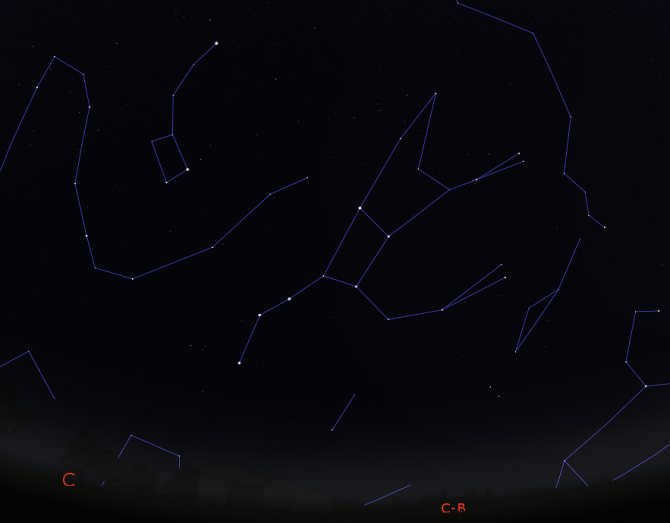
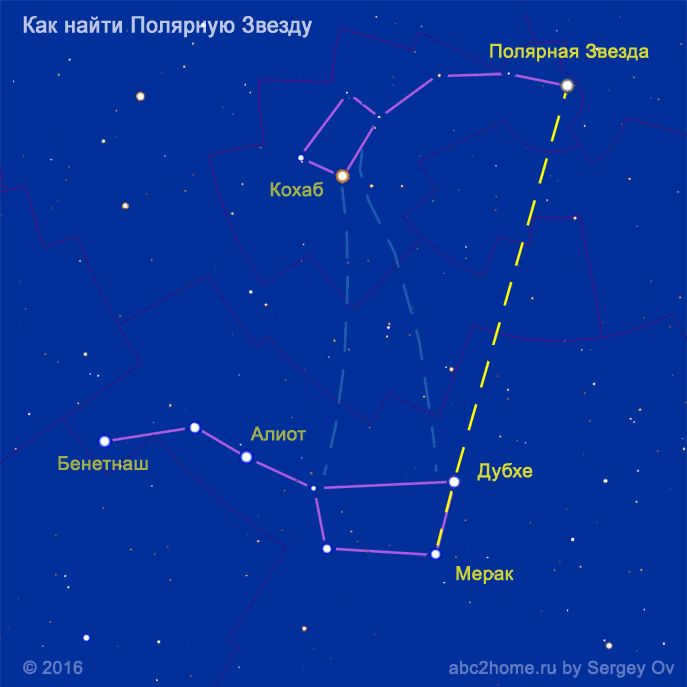
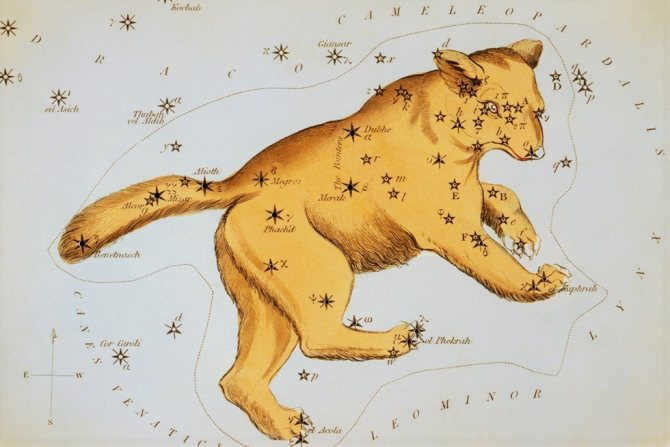
Among the options for depicting the Big Dipper on the celestial map
The Big Dipper is regarded as one of the most ancient constellations, as virtually all civilizations that have inhabited the Earth have made reference to it. The earliest mentions of this star cluster can be found in India, where it was known as “Sapta Rishi” (seven sages). This name came about due to the seven primary stars that form the Dipper. The Chinese also took note of this constellation and used its position in the sky to determine time.
According to Greek mythology, the Big Dipper holds a fascinating tale. It is well-known that Zeus had a fondness for beautiful women, and Callisto, the daughter of the king of Arcadia, was no exception. When Zeus’s wife Hera discovered their affair, she sought revenge. To protect Callisto from Hera’s wrath, Zeus transformed her into a bear and placed her in the sky, where she would be safe.
The Indians also recognized the figure of a bear in this constellation, but their interpretation differs slightly. They believe that the bear is represented by four stars arranged in the shape of a trapezoid. Additionally, they see three hunters pursuing the bear: Aliot leads the way with a bow, Mitzar carries a cauldron, and Benetnash brings a pile of brushwood for kindling a fire.
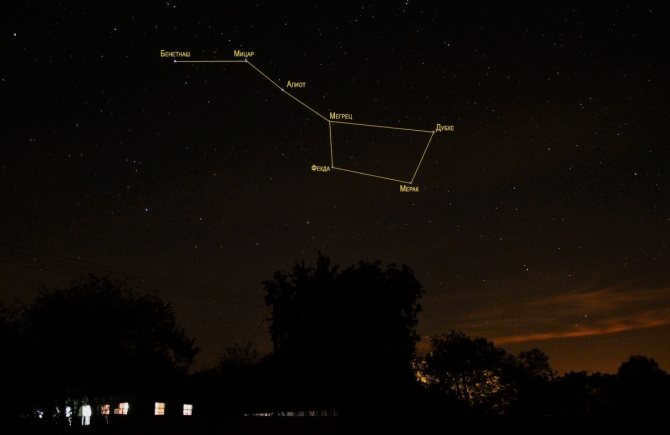
There are a significant number of stars that make up the main stars of the Ursa Major constellation. However, within its asterism, known as the Big Dipper, there are specifically seven luminaries that form a distinctive shape. Thanks to advancements in modern technology, astronomers are able to continuously observe these stars and gather the necessary information. The Big Dipper’s asterism is composed of the following:
- Dubhe – serving as the alpha star, Dubhe is recognized as the second brightest star in the constellation. Thorough studies have revealed that Dubhe is actually made up of two stars: a main sequence star and an orange giant.
- Merak is the beta star of the cluster. While it may not be the most prominent in the night sky, it shines 69 times brighter than the Sun.
- Fekda – a luminary positioned at the bottom of the Big Dipper, beneath the handle.
- Megretz is the least bright star in the Big Dipper.
- Aliot – the most prominent star in the cluster, easily visible in the night sky.
- Mizar – not very visible due to the nearby star Alcor being almost twice as bright.
- Alkaid – the furthest luminary from the rest of the group, situated at the end of the handle of the Big Dipper.
In addition to the seven stars in the asterism, there are approximately 125 other stars in the constellation. However, only a few dozen of them can be seen with the naked eye. The three brightest stars to the right of the Dubhe-Merak pair form a triangle. Similarly, in the lower right corner of the Big Dipper, there is another triangle formed by the stars lambda, mu, and psi.
Did you know? In some cultures, these two triangles symbolize the hind and front paws of a bear.
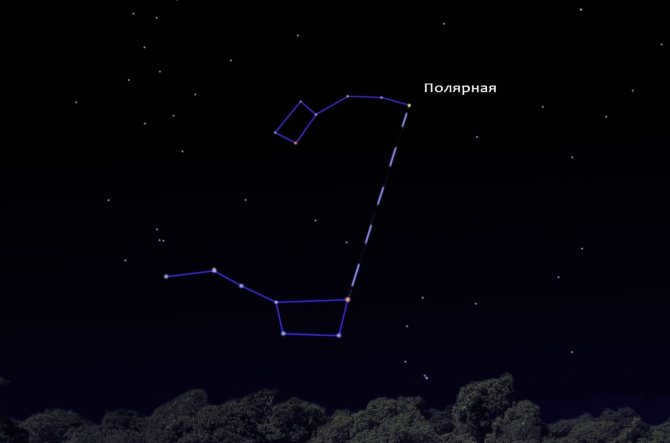
Image depicting the position of Polaris in relation to the Big Dipper
In addition, there are several important stars located to the right of the Big Dipper, and in Russia, only two stars are hidden behind the horizon. Since the constellation is always visible in the sky in the Russian Federation, local astronomers and stargazers can easily locate the following celestial objects:
- Polaris;
- Cassiopeia;
- The constellation of Leo is nearby;
- The stars Capella and Arcturus;
- The constellation Gemini;
- The constellation Virgo.
Interesting fact: Venus – description, structure, characteristics of the planet, interesting facts, photos, and videos
If you are aware of the specific position of these objects relative to the Big Dipper, it is quite simple to locate them.
Stellar bodies in the constellation of the Big Dipper
The Big Dipper constellation is considerably larger than what most individuals perceive, and it extends beyond the well-known group of seven stars that resemble a “bucket”. In terms of spatial extent, it is ranked third among all constellations, surpassed only by Hydra and Virgo. The naked eye can observe up to 125 stars within this constellation.
The stars comprising the “bucket” of the Big Dipper are the most brilliant within this constellation, although their luminosity is approximately 2 star magnitudes, with the exception of Delta – its brightness measures 3.3m.
All the stars in the “bucket” constellation have unique names such as Dubhe, Merak, Fekda, Kaffa, Aliot, Mitsar, and Benetnash. One of the most renowned stars in this constellation is Mitzar, which is located in the middle of the handle of the dipper. Mitzar is actually a binary star system, and individuals with exceptional eyesight can even spot its companion star, Alcor.
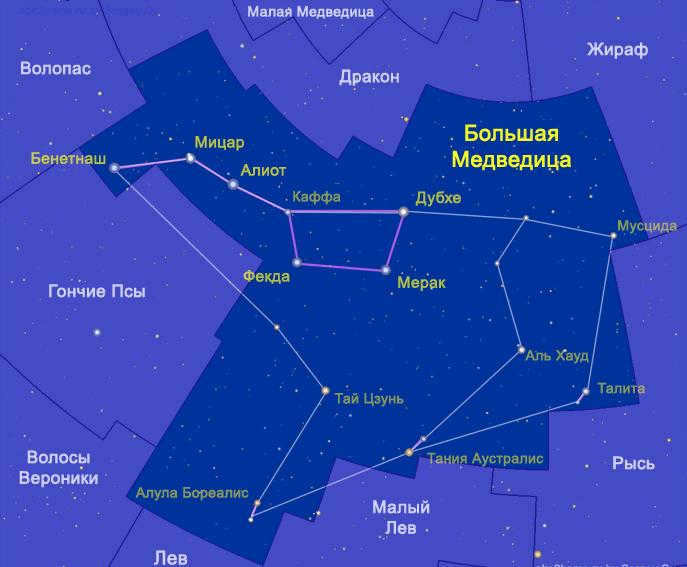
The celestial bodies in the formation of the Big Dipper.
Merak and Dubhe are commonly referred to as the Pointers – by extending a line through them, one can easily locate Polaris. The constellations of the Little Dipper and Big Dipper are positioned near each other, simplifying the identification of Polaris.
All of the stars in the “bucket” of the Big Dipper appear to be equally distant from us because they have approximately the same brightness. However, this is not actually the case. Some of these stars are closer to us, while others are much farther away. The fact that they form this pattern is simply a result of chance. Due to the stars’ movement in space, the shape of this constellation changes significantly over time. In 10,000 years, this shape will no longer be visible in the sky, just as it was not visible 10,000 years ago. However, five of these stars are moving in the same direction and share similar characteristics, suggesting that they may have a common origin. These stars are known as the moving group of stars in the Big Dipper.
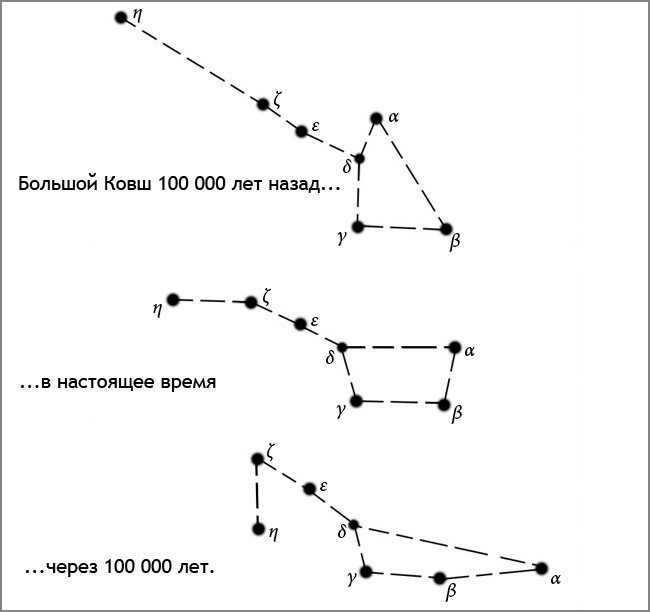
The motion of the stars in the constellation Ursa Major in the vast expanse of space.
Ursa Major, also known as the Big Dipper, is a celestial formation abundant with numerous binary and even multiple star systems. However, the majority of these stars are either too faint or too proximate to be observed through most amateur telescopes. Additionally, there are numerous variable stars in this constellation, yet their luminosity is also quite low, necessitating the use of a telescope or high-quality binoculars for proper study.
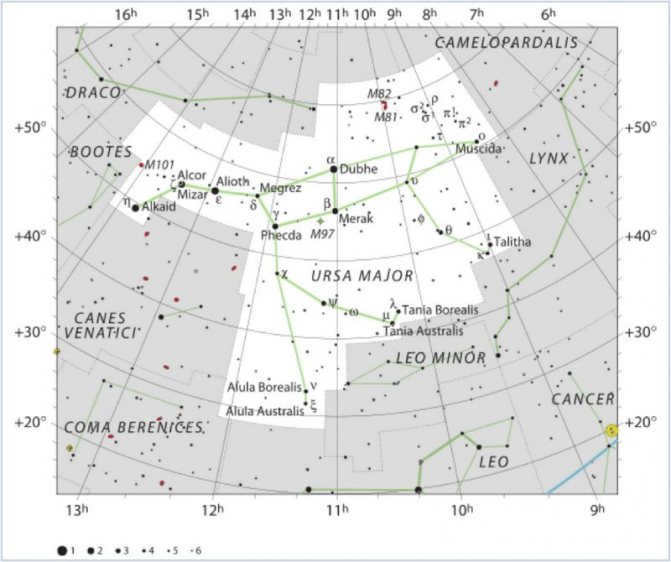
Here is a map displaying the arrangement of stars in the Big Dipper constellation.
The Mizar system consists of six stars
Mizar occupies the central position in the handle of the Big Dipper, resembling a “bucket”. It is particularly interesting due to its dual nature, making it one of the most well-known and easily observable double stars. The second component is referred to as Alcor – a dim star with a luminosity of 4.02m, positioned 12 arc minutes away. Alcor is only visible to individuals with exceptional eyesight, making it a popular eye examination tool.
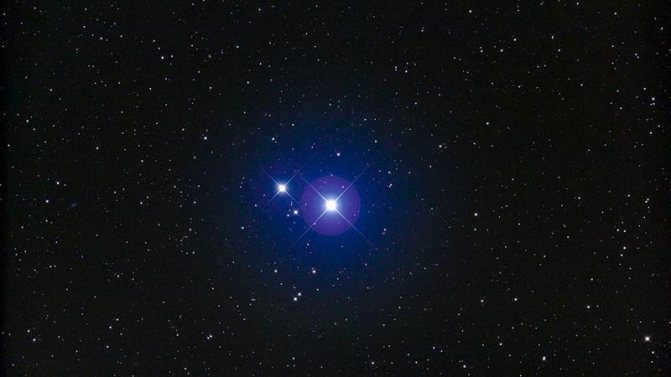
There was a lack of evidence for a long time regarding the physical connection between Mitsar and Alcor, as their distance in space is a quarter of a light year and the stars move very slowly in their orbit. In 2009, however, evidence was finally obtained, revealing that the Mizar-Alcor system is not just a binary system, but actually a sextuple system!
The Mizar star system, when observed through a small telescope, appears as a double star with its A and B components separated by 15 angular seconds. These stars have a luminosity of approximately 4m. Interestingly, each of these components is also a binary system, meaning that Mizar is actually a quadruple star system. The A component is comprised of two hot white stars, each 3.5 times larger and 2.5 times more massive than our Sun. On the other hand, the stars in the B component are also white stars, but they are slightly smaller, being twice as large and 1.6 times heavier than our Sun.
Alcor, on the other hand, is not as straightforward as it may first appear. It is a binary system that consists of a hot white star, which is twice as massive and larger than our Sun, and a red dwarf star, which is four times lighter than our Sun and three times smaller in size.
In the Mizar system, there is an intriguing group of five nearly identical hot white stars and one red dwarf. A similar and equally fascinating six-star system can be found in the Gemini constellation, known as the star Castor.
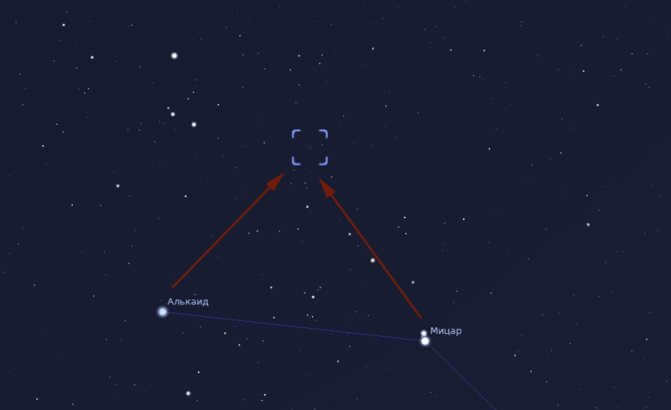
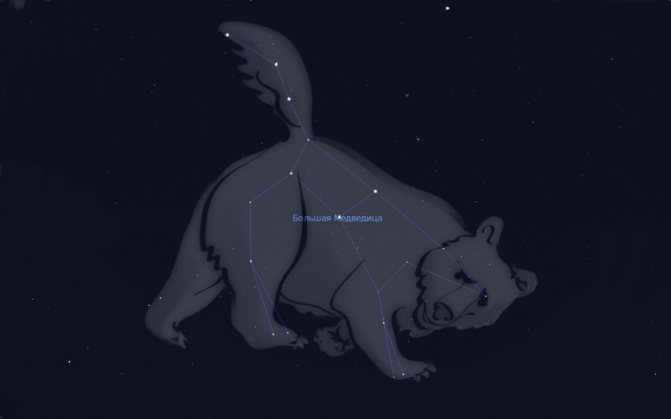
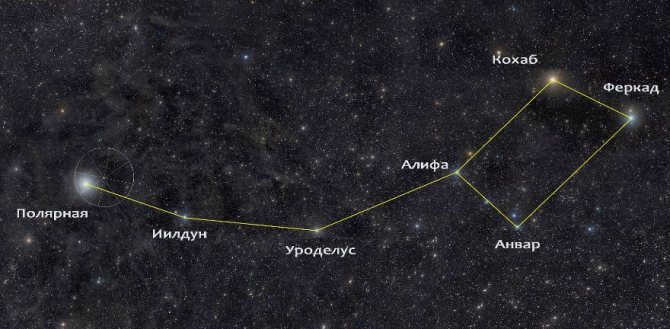
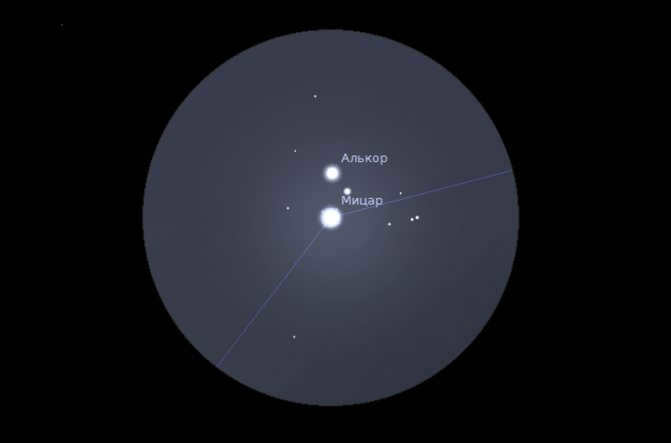
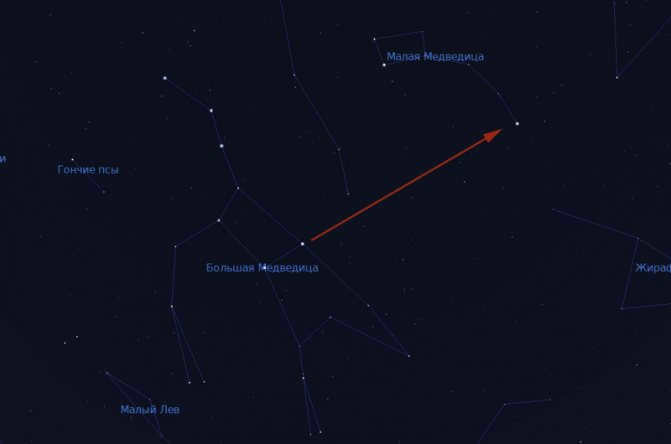
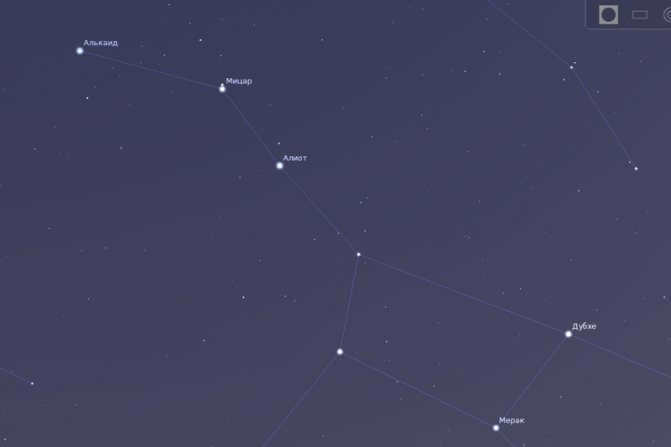
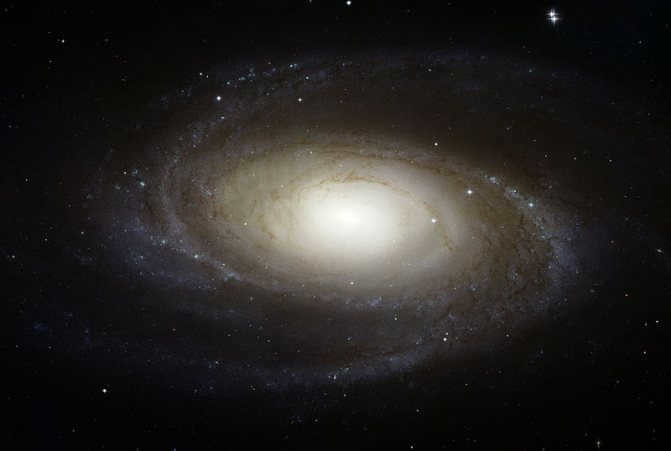

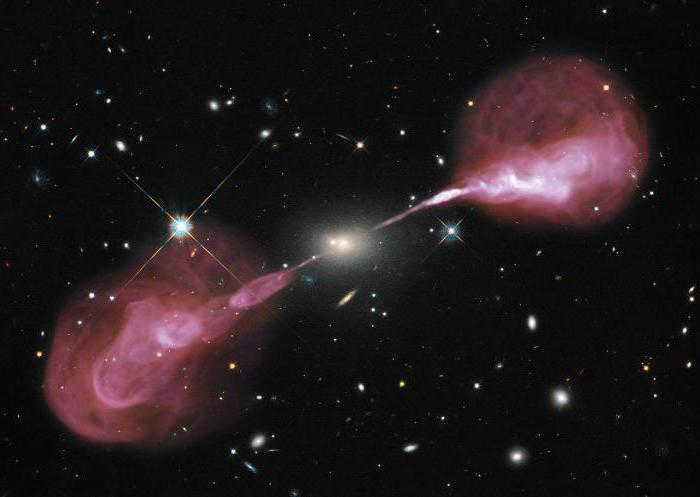


The assortment of items within the constellation Ursa Major
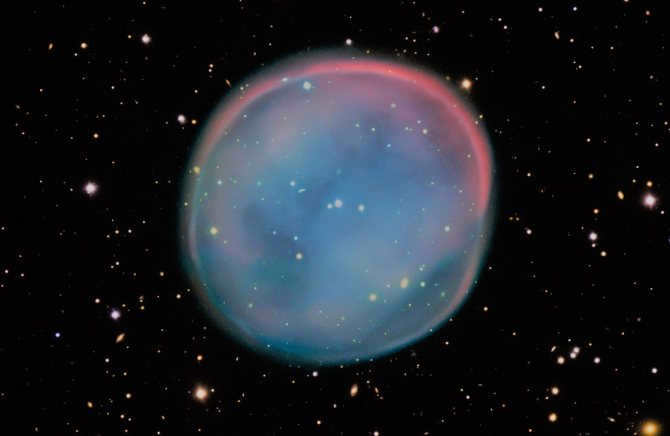
The Owl Nebula, also known as M97, is one of the few objects in the Big Dipper that can be observed with an amateur telescope. Most of the other objects in this constellation require professional equipment for visibility. The Owl Nebula is located near the star Merak.
Galaxies
Within the region of the celestial dome where the constellation Ursa Major resides, there exists a remarkable assemblage of approximately 1,500 galaxies that have captured the attention of astronomers. Notably, due to its location within the expanse of the Milky Way, a majority of these galaxies can be observed through the lens of a sophisticated telescope.
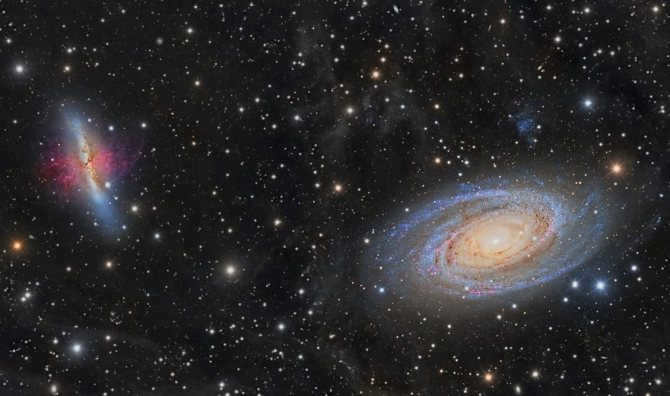
Galaxies M81 and M82
Located 12 million light years away from Earth are the Cigar, Bode, and Vertushka galaxies, which are designated as M82, M81, and M101, respectively. Among them, the first is renowned for its stunning appearance in space. Its arms emit a violet-blue glow, while the central region is distinctly visible and appears as a blue sphere.
The Vertuska galaxy, with its spiral shape, features elongated rounded tails and numerous bright objects surrounding it. These objects have been described by astronomers as resembling exploding fireworks due to their resemblance.
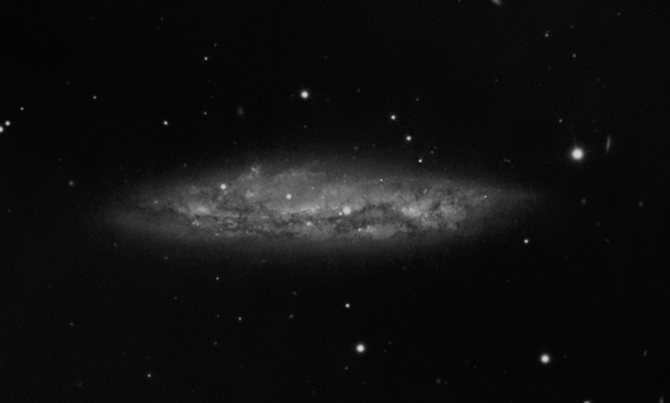
The galaxy M108 can be observed near the star Merak. Due to dust clouds, its center is not visible and its brightness is absorbed, making it approximately 12m when observed from Earth.
The Dustman galaxy, designated as M109, can be seen not far from the Feqda luminary. It is known to be one of the most challenging objects to observe as its glow is often overshadowed by stars.
Astronomers regularly discover new galaxies with unique features as they observe the sector where the White Bear is located. Its favorable position in the sky allows for the observation of even the most distant objects.
Resources related to the subject
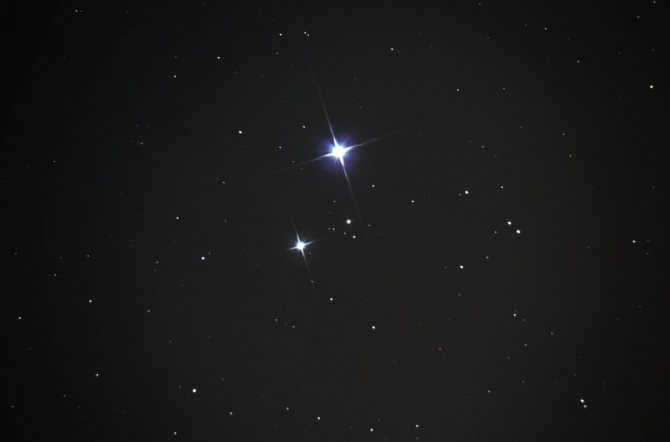
It is interesting to note that the Great Bear constellation is also known by another name – “The Funeral Procession”. In this interpretation, the three stars represent mourners, led by a leader (“Al-kaid banat nash”), with funeral stretchers following behind them.
On average, the stars that make up the Big Dipper are located approximately 120 light-years away from Earth. These stars are not the brightest in the night sky, with an average stellar magnitude close to 2m. However, they are still relatively easy to spot.
It is worth mentioning that a recent study conducted in 2009 revealed that Mizar and Alcor form a complex system consisting of six stars. This system includes the double stars Mizar A and B, which orbit around the double star Alcor. It is not surprising that these stars are frequently found in pairs and clusters.
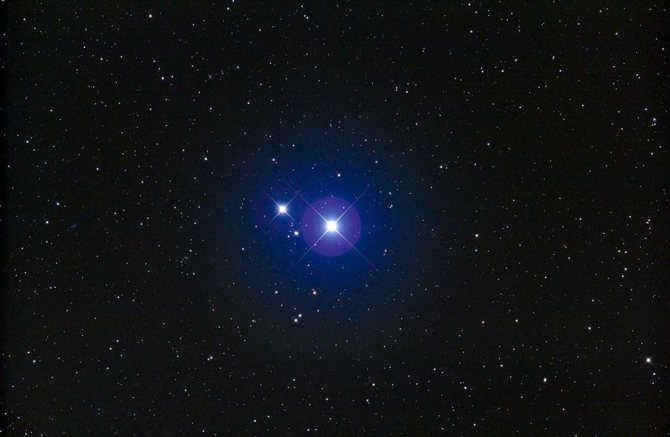
Additionally, you might be interested in: Mushroom rainmaker – a detailed overview of the appearance, species, characteristics, beneficial properties, and culinary significance of a unique mushroom.
Ursa Major: a magnificent sight during autumn
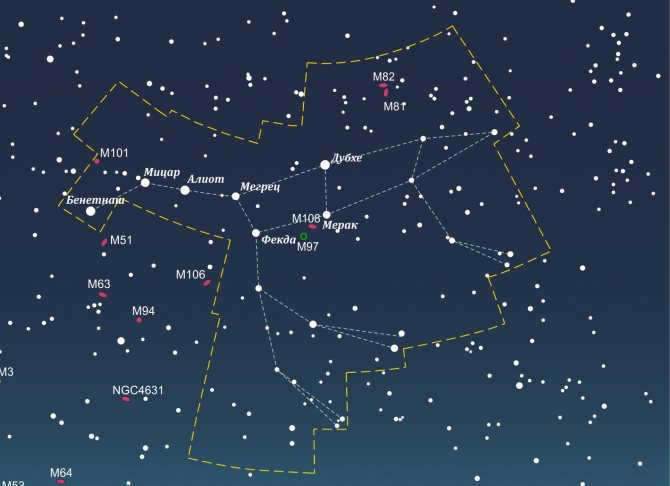
The appearance of the constellation Ursa Major in autumn
Due to the constant movement of celestial objects, the position of the Big Dipper varies throughout the year. During the fall season, most stars are obscured from view. However, the asterism of this constellation is an exception. Its seven main stars may not shine as brightly between September and November, but they are still visible to the naked eye.
In autumn, the Big Dipper can be found in the northern part of the sky, positioned below Polaris. The dipper is tilted with its handle pointing towards the west. To the east, one can observe the Pleiades constellation, with Aldebaran shining nearby. In the northeastern direction, the prominent stars that form the Gemini constellation can be seen.
In the autumn sky, the constellations are regarded as the most luminous:
These groupings can be viewed during the nighttime without any specialized equipment. To observe other celestial objects, astronomers utilize specialized telescopes that possess sufficient magnification to bring the desired stars and galaxies closer. For instance, the Hubble telescope is capable of observing over a thousand galaxies within the stellar region of the Ursa Major constellation. As a result, scientists are not required to take seasonal hiatuses and cease their work.
The Story of Cassiopeia and the Dragon
Discovering Cassiopeia
To find Cassiopeia, start by observing the second star from the end of the Big Dipper’s “bucket handle” star, known as Mizar (refer to the diagram below). Visualize a straight line extending from Mizar through Polaris and continuing for the same distance. You will then come across a brilliant constellation in the shape of the letter W, which is Cassiopeia.
Locating the Dragon
The Dragon constellation can be found nestled between the Big Dipper and the Little Dipper. To locate it, simply identify the two “buckets” of the dippers.
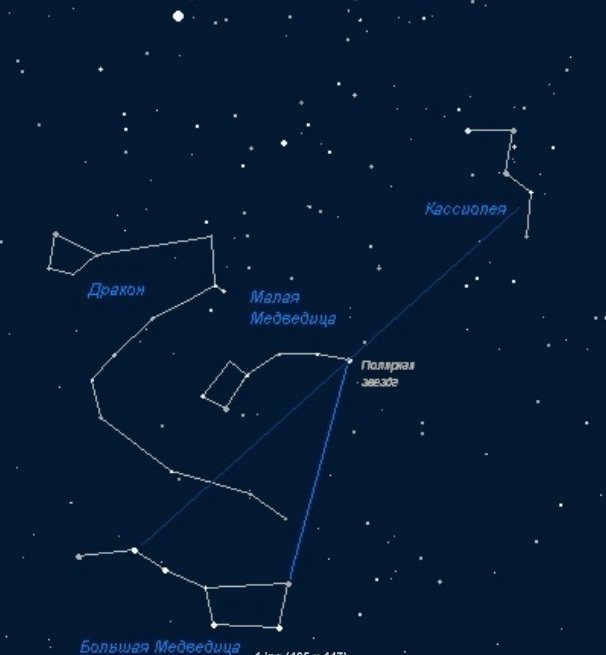
Constellations. Photo: meteoweb.ru
The constellations known as the Big Dipper, Little Dipper, Cassiopeia, and Draco can be seen in the Northern Sky. Due to their close proximity to the North Pole, these constellations never set in the European region of the former USSR.
Debunking misconceptions surrounding the Big Dipper’s origin
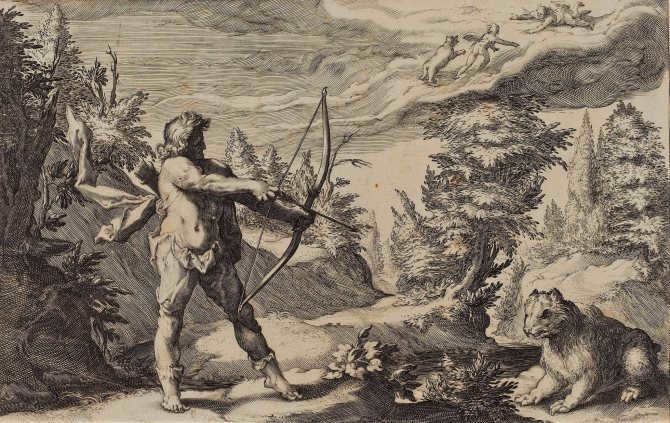
There are various legends surrounding the origin of the constellation. One of the most fascinating and popular is the Greek myth. As mentioned before, it tells the story of Callisto, the daughter of the king of Arcadia, who caught the attention of Zeus.
However, there is another version of this myth. In her youth, Artemis would often venture into the forest for hunting, seeking out different kinds of game. She would bring along young girls of exceptional beauty to assist her. Among them, Callisto stood out as the most radiant.
Zeus was enchanted by Callisto’s beauty. In order to win her favor, he disguised himself as Artemis. After some time, Callisto gave birth to a son named Arcades. When Zeus’s wife Hera discovered what her husband had done, she became furious and transformed Callisto into a bear with an unappealing appearance.
Arkad was raised and eventually became a hunter. While on a hunt, he encountered his mother disguised as a bear. Unaware of her true identity, he prepared to shoot her with his bow. However, Zeus intervened and transformed both of them into constellations that now adorn the night sky. Callisto became the Big Dipper, while Arkad became the Little Dipper.
Ever since that fateful encounter, they have remained together in the celestial heavens, appearing as if they are watching over each other due to their unique positions. If one is able to locate one constellation, finding the other becomes an effortless task.
Did you know? The Big Dipper’s shape gradually changes over the course of the year, as the stars Benetnash and Duhbe move in the opposite direction compared to the rest of the stars in the constellation.
Composition of the Big Dipper
It’s worth noting that the stars in the Big Dipper have Arabic names, even though their designations are in Greek. The brightest star in the constellation, Alioth, is known as Epsilon. Translated, its name means something akin to a turkey. The star Alpha, also known as Dubhe or “bear,” is a spectroscopic star. Beta, or Merak, is a celestial luminary that belongs to the main sequence. Alkaid, the last star in the Big Dipper, is a young star in the main sequence and is sometimes referred to as Benetnash. Interestingly, there is no exact translation for this name, but it is often associated with being the leader of the mourners.
Gamma of the constellation Fekda (thigh) is also part of the main sequence. It exhibits emission lines in its spectrum, indicating the presence of a gas shell. The faintest of the seven luminaries in terms of brightness is Delta – Megrez, which is known as the beginning of the tail. However, it is still classified as an object of the main sequence. Zeta – Mizar, also known as the loincloth, is located in the middle of the Bucket. It is a binary star system consisting of two double stars. Astronomers have successfully captured images of this system, making it the first of its kind to be photographed.
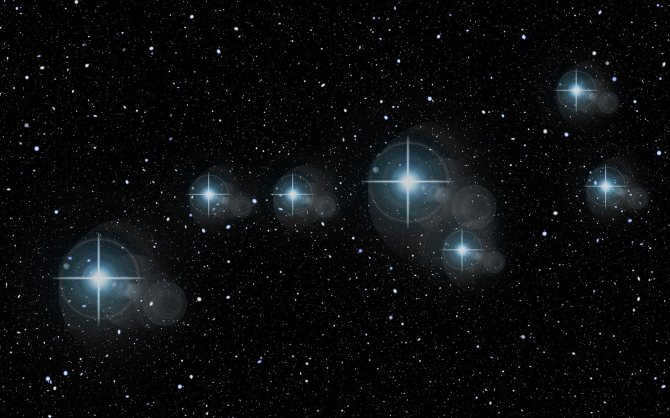
Artificial highlighting of the stars in the Big Dipper
In order to catch sight of the Big Dipper in the Russian Federation, one must venture outside the city limits, away from the glare of city lights that obscure celestial objects. The optimal time for observing this cluster falls between the months of March and April.
Fascinating fact During the initial weeks of April, the residents of Moscow can witness the Big Dipper at its highest point.
During these months, the Big Dipper ascends to the zenith, and every night, around 11:00 PM, the stars reach their peak brilliance. By simply looking up, a person can easily locate the Dipper. And if they happen to possess even a pair of amateur binoculars, they will be able to examine not only the seven primary stars but also the neighboring objects.
The fall is not the optimal time to observe the Big Dipper, as its brightness diminishes and a telescope becomes necessary to identify the neighboring stars associated with the constellation.
Utilizing the Big Dipper as a guide
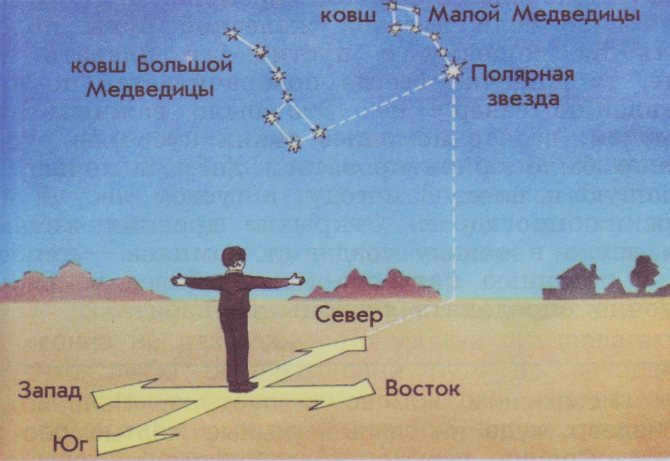
Using the Big Dipper and Polaris for Navigation
Due to its brightness, the Big Dipper has served as a dependable navigational tool for centuries. Seasoned explorers could determine their position in the world by locating the sides of the compass using the Dipper.
Most importantly, the Big Dipper can help locate Polaris in the night sky. By mentally drawing a straight line from this celestial body to the Earth, one can accurately determine the direction of the north.
Interesting fact: In ancient Russia, this constellation was known as the Horse due to its distinctive shape. The North Star was believed to be a peg to which the horse was tethered.
Once you have identified the position of the north, it becomes easy to ascertain the other directions: south – behind, west – on the left, east – on the right. The stars Arcturus and Spica, which can be found in the south, serve as helpful guides in navigating through space. During the Middle Ages, sailors relied on these stars to accurately set their course while out at sea, even in the darkest of nights.
The great advantage of using the Big Dipper as a point of reference is that it spans a significant portion of the sky. Even in cloudy conditions, there is a high likelihood that at least a portion of the constellation will still be visible. This alone can be enough to determine the location of the north.
Originally, this particular part of the sky was primarily associated with the Big Bucket asterism, so most of the names that existed were accordingly related:
- The ancient Greeks referred to the constellation as Helica, which means “shell”, and sometimes as Arctos, which means “bear” or “bear”. According to certain Greek authors, the Big Dipper served as a guide for the ancient Greeks. According to Greek mythology, Zeus transformed two nymphs from Crete into bears to protect them from Cronus. Another version of the story suggests that the nymph Callisto transformed into a bear to hide from her sister and wife, Hera.
- The Indian name of the constellation in Sanskrit is similar to “Sapta Rishi”, which translates to “seven sages”. This name is associated with the seven sons of Brahma, who are believed to be the ancestors of all and the creators of the universe. In Indian astronomy, these seven stars are referred to by the names of the sages.
- In Kazakh culture, the constellation is known as “Seven Robbers” or “Zhetikarakshy”. According to a legend, the sky deity Tengri tied his two horses to the Iron Peg, which represents the Polar Star (“Temirkazyk”), and the horses are represented by two stars close to it, possibly Polar A and Polar B. The seven stars of the Big Bucket are depicted as robbers who continuously circle around the horses, attempting to steal them.
- The constellation known as “Northern Bucket” (or “Beidou” in Chinese) earned its name because, according to Chinese astronomers, the handle of the Big Bucket pointed directly towards the north pole during those times.
- In Slavic culture, this same constellation was referred to as the “Elk” constellation due to its association with this majestic animal. In ancient Russia, the Big Dipper was also known as the “Horse on a Pin,” symbolizing the Big Dipper as a horse pinned to Polaris, continuously circling around it – like a pin.
Since ancient times, humans have been captivated by the night sky. There is an inherent allure in gazing at a clear moon and distant stars. All of this has a soothing and tranquil effect on the soul.
If you look up at the sky with curiosity, you will eventually start noticing unique arrangements of stars that create different shapes. One of the most recognizable constellations is the Big Dipper, which we will explore extensively in this article.

The Ancient Depiction of the Big Dipper
The Big Dipper has been a prominent constellation in the night sky since ancient times. It holds significance in various cultures around the world.
The Hindus were the first to take notice of this constellation and named it “Sapta Rishi” in Sanskrit, which translates to “seven sages”. In Chinese astronomy, it was referred to as the “Northern Bucket”. The resourceful Chinese even used it as a means to measure time.
Video: MaJey explains the concept of Constellations featuring the Big Bear
A radiant ladle in the nocturnal heavens
Let’s now examine the ladle-shaped formation within the Big Dipper. It is most stunning during the autumn season. In scientific terms, this constellation ranks as the third largest in terms of area, surpassed only by Hydra and Virgo. It spans an impressive 1,280 square degrees. The Big Dipper (a photographic representation of which is displayed below) consists of a visible segment comprising seven prominent stars. Let’s outline them:
- Dubhe – also known as the Bear;
- Merak – commonly referred to as the Lumbar;
- Fekda – sometimes called the Thigh;
- Megretz – marks the commencement of the tail;
- Aliot – often identified as the Curdle;
- Mitzar – known as the Loincloth;
- Benetnash – recognized as the leader of the mourners.
All of these names are of Arabic origin and represent the 7 bright stars that collectively form the legendary ladle.
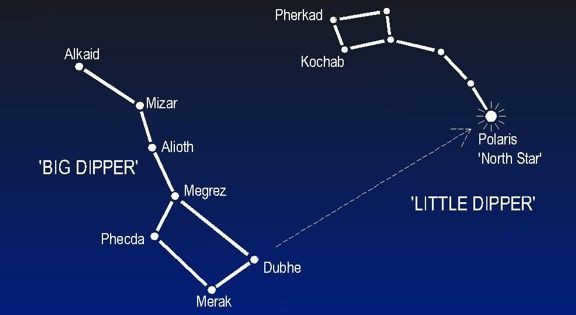
Position in the Celestial Sphere
The celestial sphere would be incomplete without the presence of the Big Dipper constellation. During the autumn season, the Big Dipper can be found in the northern part of the sky. It is best visible between 3-4 o’clock in the morning, just above the north-eastern horizon. A helpful guide would be to locate its handle, which points towards the direction of sunrise.
The Big Dipper – an Introduction to Astronomy
Novice astronomers can start their journey by learning how to locate the Big Dipper in the autumn season (see photo of the constellation below). This collection of stars is easily visible in the night sky and serves as a great starting point for young enthusiasts. By studying the Big Dipper, beginners can:
- Develop the skill of identifying less prominent constellations in the sky. Experienced astronomers often use the Big Dipper as a reference point for locating other stars.
- Engage in fascinating observations of the night sky throughout the year. They can observe how familiar stars change their positions and track the monthly movements.
- Practice their mathematical skills. Over time, astronomers can memorize the angular distances between the stars in the dipper.
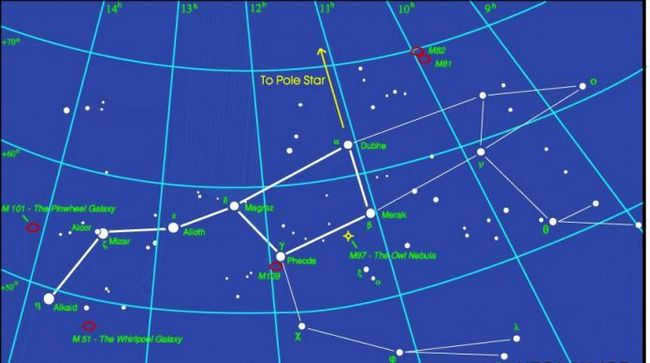
Watch: Unexpected Discoveries in Big Bear
The Great Ladle: the vessel during autumn
The position of the constellations is heavily influenced by the time of year. The Great Ladle (ladle) during autumn is no exception to this pattern.
The autumn sky lacks an abundance of stars. Even the traditionally luminous Great Ladle constellation appears dimly. During autumn, the handle of the Great Ladle can be found in the northern sky, positioned below Polaris with its tail pointing west. Cassiopeia is located directly overhead.
However, in the eastern sky, the Pleiades constellation rises prominently, with the bright star Aldebaran shining directly below it in the Taurus constellation. During this time, two bright stars ascend in the northeast, which an experienced stargazer would immediately recognize as Gemini.
The constellations Leo and Virgo are not visible at all as they are hidden behind the Earth. However, if you look to the west of the Big Dipper, you might be able to distinguish the barely visible constellation Eagle.
Now, let’s summarize the constellations that can be seen in the northern part of the fall night sky:
- The Big Dipper;
- The Little Bear;
- Gemini;
- Taurus;
- Lyra and Swans.
Exploring the Patterns in the Celestial Vault
Once you spot the Big Dipper in the autumn sky, you may find yourself captivated and spend an hour or two searching for other familiar stars. All you need is a genuine curiosity and, of course, a star chart to guide you.
Now, let’s direct our attention to the southern region of the sky. It is here that the constellations of Andromeda and Pegasus grace the night sky during the autumn season. In the upper left corner of this celestial expanse, you will find two stars belonging to the first constellation, always followed by three stars from the second constellation.
Below Andromeda, you can observe a pair of diminutive stars – those are Aries. And just below, there are numerous radiant specks dispersed – this represents the constellation of Cetus. Aries and China are exclusively visible during optimal atmospheric conditions.
Within Pegasus, apart from the trio of brilliant stars, it is noteworthy to recall an additional duo: they are situated towards the right-hand side. The overall shape of Pegasus resembles a set of horns. One cannot help but sense the desire of these horns to gently prod the Swan.
Image: The autumnal Big Dipper’s ladle

Video: Tips for locating Polaris and the Little Dipper. Illustration of the Big Dipper (Infographic).
Observing a clear sky is a great way to stimulate creativity. After spending time contemplating the night sky, you may find yourself inspired to engage in various creative activities. Some may feel compelled to write a captivating story about their nighttime experience, while others may feel the urge to dance to their favorite music. And then there are those who may want to sketch the luminous bucket.
Today, we will focus on the art of sketching the Bear.
Drawing a ladle is actually quite simple, as it is essentially a geometric shape consisting of an inverted trapezoid and a broken straight line. However, when it comes to the background, placement, and color of the drawing, you have the freedom to experiment and express your own unique vision. Each person will have their own interpretation of how the peculiar figure should be depicted on the sheet of paper.
Video: The Saratov 2015 Big Dipper Cycling Race
The Significance of the Big Dipper in Various Cultures

- The group of stars known as the Big Dipper is actually an asterism, which is a smaller pattern within a larger constellation. This particular asterism represents a funeral procession, with two stars called benetnash symbolizing mourners.
- Arctos is the oldest name for the Big Dipper and it dates back to the prehistoric era of nomadic hunters. This shows that people from all time periods have been fascinated by the beauty of the night sky.
- The Big Dipper, also known as the Bucket in the fall, is featured on the flag of Alaska.
- In the world of anime, there is a character named Kenshiro who has a scar on his chest in the shape of a bucket. Russian viewers can enjoy the exciting three-part novella Fist of the North Star: New Era, which features cosmic adventures.

